 Creation index
 |
Seminar 7 Questions and Answers, part b |
 |
(this seminar was given in 2005) |
(some parts of the originally given seminar appear removed in the latest English DVD release of this,
that what is presented here is the unedited version) |
| [Introduction to Dr. Hovind], [Dr. Hovind's justice cycle], [Is Dr. Hovind being edited?], [Dr. Hovind vs Wikipedia] |
| [Video presentation of seminars 1-7], [Introduction to seminar transcripts], [Seminar 1: “The Age of the Earth”],
[Seminar 2: “The Garden of Eden”],
[Seminar 3: “Dinosaurs and the Bible”],
[Seminar 4: “Lies in the Textbooks?”],
[Seminar 5: “The Dangers of Evolution”],
[Seminar 6: “The Hovind Theory”],
[Seminar 7: “Question and Answers”] |
| |
| |
“The heart of the prudent getteth knowledge; and the ear of the wise seeketh knowledge.” |
|
| |
|
Proverbs 18:15 |
|
Seminar 7: Questions and Answers (part b)
Go to “Questions and Answers” index page
 About the redshift and if that accounts for an expanding universe that would be millions of years old... About the redshift and if that accounts for an expanding universe that would be millions of years old...
Ok, let's go on to the question about the redshift. “Doesn't that prove that the universe is expanding? Or doesn't that prove that the universe is billions of years old?” Let me explain what they are talking about.
 Redshift defined Redshift defined
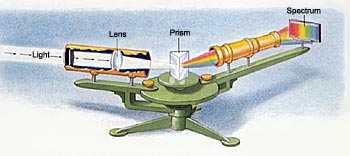 If light shines through a prism, it breaks it up into the rainbow colors; red, orange, yellow, green, blue, indigo and violet. Now if you take starlight and shine it into a prism, by putting a prism onto the back of your telescope, the light shines through and it gets broken up into the same colors; red, orange, yellow, green, blue, indigo, and violet. And you can kind of tell what's burning, because different things burn different colors, like copper burns green. If light shines through a prism, it breaks it up into the rainbow colors; red, orange, yellow, green, blue, indigo and violet. Now if you take starlight and shine it into a prism, by putting a prism onto the back of your telescope, the light shines through and it gets broken up into the same colors; red, orange, yellow, green, blue, indigo, and violet. And you can kind of tell what's burning, because different things burn different colors, like copper burns green. 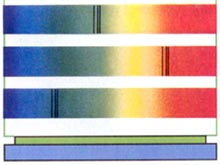 And each element produces a distinctive color and so they can kind of tell what's in the star and what it's burning by what color of light it produces. You can learn a lot about the stars from the light. However, as they look at this spectroscope, the colors it produces, there is little black lines in starlight indicating a particular element is burning, a particular element is burning, but they are shifted toward the red. You notice the center picture up there, the black lines are shifted toward the red side; and that's called the redshift. And each element produces a distinctive color and so they can kind of tell what's in the star and what it's burning by what color of light it produces. You can learn a lot about the stars from the light. However, as they look at this spectroscope, the colors it produces, there is little black lines in starlight indicating a particular element is burning, a particular element is burning, but they are shifted toward the red. You notice the center picture up there, the black lines are shifted toward the red side; and that's called the redshift.
 Doppler effect Doppler effect
So the question is, what would be causing this? Why would some of these stars have the black line shifted over toward the red? Well, there are several theories about what is causing it. The most commonly accepted theory, and probably the only one that students are ever taught in school, is that the redshift is caused by what is known as the Doppler effect. If you have ever been waiting at the train tracks when the train is coming, as the train comes toward you, it is squeezing the sound waves, and so the pitch goes up. And when the train leaves you, it is stretching the sound waves, and so the pitch drops, and it goes ééééé úúúúú, as it goes by. That's called the Doppler effect, who cares. Well, this happens whether the sound is moving past you or you are moving past the sound. It doesn't matter, you still get this Doppler effect; the change in pitch. Well, the theory is that if a star was moving toward us, it would squeeze the light waves, giving it a blue-shift and if it is leaving us, it would give us a redshift, because it would stretch the light out. That's the theory, ok. What really causes it, I don't think anybody knows for sure.
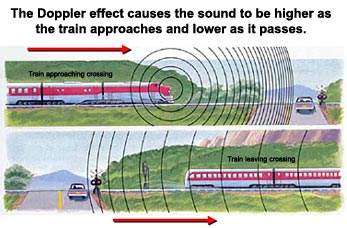 |
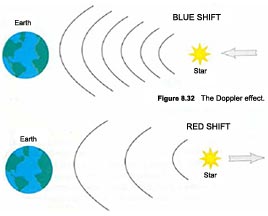 |
 Can distance be reliably measured through the use of the redshift phenomena? Can distance be reliably measured through the use of the redshift phenomena?
This guy said: “This was an early sign that redshifts reliably indicate the distances to quasars. However, the diagram shows a wide scatter in apparent brightness at every redshift. In fact, there is little correlation of brightness to redshift at all! Either quasars come in an extremely wide range of intrinsic luminosities, as most people believe, or their redshifts do not indicate distance.” I don't think anybody knows for sure what's causing the redshift, but you certainly can't tell the distance to a star based on the redshift. And that's exactly what they try to do. They look at stars, and say: “That is redshifted more. It must be 10½ billion light years away, instead of 10.2 or something.” They make up an awful lot of imagination stuff over just a real little bit of science, in my opinion. I don't think anybody knows for sure what's causing the redshift, but you certainly can't tell the distance to a star based on the redshift. And that's exactly what they try to do. They look at stars, and say: “That is redshifted more. It must be 10½ billion light years away, instead of 10.2 or something.” They make up an awful lot of imagination stuff over just a real little bit of science, in my opinion. 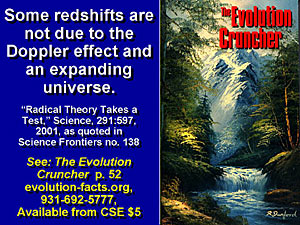 This fellow said in Sky and Telescope magazine: “Thus for us the only conclusion is that at least some quasars are relatively nearby, and that a large fraction of their redshift is due to something other than the expansion of the universe.” This fellow said in Sky and Telescope magazine: “Thus for us the only conclusion is that at least some quasars are relatively nearby, and that a large fraction of their redshift is due to something other than the expansion of the universe.” Basically he's saying that we're not sure what is causing the redshift. It may be that they are nearby. There's a good book I highly recommend this one, it is called, The Evolution Cruncher. It's a 900 page book, and it's like $5 bucks. He's got a whole section in here on page 52 about the redshift and the Doppler effect and what causes it. He's got some really good stuff. And these you could give out to every high school kid you know. But it's a good section in there about the redshift, what's causing it. Basically he's saying that we're not sure what is causing the redshift. It may be that they are nearby. There's a good book I highly recommend this one, it is called, The Evolution Cruncher. It's a 900 page book, and it's like $5 bucks. He's got a whole section in here on page 52 about the redshift and the Doppler effect and what causes it. He's got some really good stuff. And these you could give out to every high school kid you know. But it's a good section in there about the redshift, what's causing it.
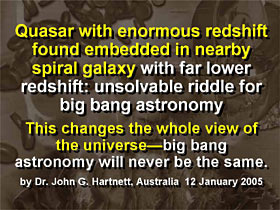 This article says: “A quasar with an enormous redshift was found embedded in a nearby spiral galaxy with a far lower redshift.” Now how can one star be inside another star, and they're giving you two different redshifts, if this indicates distance? If a quasar is inside a galaxy, they should both give you the same redshift; both being the same distance away. But they admitted they found this quasar inside a galaxy that had different redshifts, but yet they were obviously the same distance away. So they said: “According to the standard Big Bang view of the universe, the objects we call quasars are generally supposed to be at the very edge of the visible universe. They are supposed to be super-luminous black holes with a million or 100 million times more mass than our sun, surrounded by a disk of material. Some of the material falls into the black hole, causing the emission of huge amounts of energy.” This article says: “A quasar with an enormous redshift was found embedded in a nearby spiral galaxy with a far lower redshift.” Now how can one star be inside another star, and they're giving you two different redshifts, if this indicates distance? If a quasar is inside a galaxy, they should both give you the same redshift; both being the same distance away. But they admitted they found this quasar inside a galaxy that had different redshifts, but yet they were obviously the same distance away. So they said: “According to the standard Big Bang view of the universe, the objects we call quasars are generally supposed to be at the very edge of the visible universe. They are supposed to be super-luminous black holes with a million or 100 million times more mass than our sun, surrounded by a disk of material. Some of the material falls into the black hole, causing the emission of huge amounts of energy.” There's a big article when they discovered this: “Discovery Poses Cosmic Puzzle: Can a ‘Distant’ Quasar Lie Within a Nearby Galaxy?” There's a big article when they discovered this: “Discovery Poses Cosmic Puzzle: Can a ‘Distant’ Quasar Lie Within a Nearby Galaxy?” This really created a problem. How on earth can we have these two objects that are different distances, at the same location? Well, it's not a problem if you realize that you can't trust the redshift to measure the distance. But they are so anxious to say that the universe is billions of light years across, and it probably is, and use that as evidence to say: “Therefore it's billions of years old.” And that's why this all becomes a problem for them. If they would just accept the Bible, then it wouldn't be a problem at all. This article says: “Quasar with enormous redshift found embedded in nearby spiral galaxy with far lower redshift: unsolvable riddle for Big Bang astronomy.” I agree. If you believe the Big Bang theory; that is an unsolvable problem. This really created a problem. How on earth can we have these two objects that are different distances, at the same location? Well, it's not a problem if you realize that you can't trust the redshift to measure the distance. But they are so anxious to say that the universe is billions of light years across, and it probably is, and use that as evidence to say: “Therefore it's billions of years old.” And that's why this all becomes a problem for them. If they would just accept the Bible, then it wouldn't be a problem at all. This article says: “Quasar with enormous redshift found embedded in nearby spiral galaxy with far lower redshift: unsolvable riddle for Big Bang astronomy.” I agree. If you believe the Big Bang theory; that is an unsolvable problem.
 The Hubble constant The Hubble constant
Science News ran an article that said: “Another set of observations indicates that the universe appears to be 8.4 to 10.6 billion years old. The new work relied on the Hubble Space Telescope to obtain the distance to far away galaxies. A team led by Tanvir of the University of Cambridge in England used a two-step method to estimate the Hubble constant.” Now stop and think about that. How many of you have had algebra before? Have you had algebra? You have variables in your equation, ok. Well, if one variable times the constant. If one constant changes, that is going to change your whole answer. So most of this distance stuff they are doing with stars is based on what they call the Hubble constant, but they don't even know what that is. The Hubble constant is estimated. That's going to radically affect the outcome of your equation. So is the universe 8.4 billion years old or is it 10.6, or is it...? When I debated Hugh Ross, of Reasons to Believe, he said it's 17.42 billion years old. 17.42, how do you know that? Some textbooks say 18; some say 20; some say 12. The numbers range all over the scale. The fact is, they don't know. They're making up numbers, purely making them up. Now stop and think about that. How many of you have had algebra before? Have you had algebra? You have variables in your equation, ok. Well, if one variable times the constant. If one constant changes, that is going to change your whole answer. So most of this distance stuff they are doing with stars is based on what they call the Hubble constant, but they don't even know what that is. The Hubble constant is estimated. That's going to radically affect the outcome of your equation. So is the universe 8.4 billion years old or is it 10.6, or is it...? When I debated Hugh Ross, of Reasons to Believe, he said it's 17.42 billion years old. 17.42, how do you know that? Some textbooks say 18; some say 20; some say 12. The numbers range all over the scale. The fact is, they don't know. They're making up numbers, purely making them up. 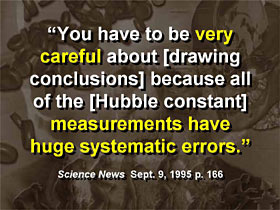 The article goes on to say: “You have to be very careful about drawing conclusions because all of the Hubble constant measurements have huge systematic errors.” I like this article which came out in Discover magazine a couple years ago: “Astronomers believed the Veil, one of the best studied supernova remnants, was 2,500 Light Years away and 18,000 years old. They were quite wrong. In fact, the Veil is only 1,500 Light Years away and 5,000 years old.” The article goes on to say: “You have to be very careful about drawing conclusions because all of the Hubble constant measurements have huge systematic errors.” I like this article which came out in Discover magazine a couple years ago: “Astronomers believed the Veil, one of the best studied supernova remnants, was 2,500 Light Years away and 18,000 years old. They were quite wrong. In fact, the Veil is only 1,500 Light Years away and 5,000 years old.” See, just four years ago, they were discovering they had radically wrong numbers. How do you know any of the numbers they are telling us are right? I think we should say: “Look, until somebody's proven the Bible wrong, I'm gonna believe it.” Instead of saying: “Well, scientists are saying it's wrong. So, therefore we must believe the scientists.” Don't go along with that. See, just four years ago, they were discovering they had radically wrong numbers. How do you know any of the numbers they are telling us are right? I think we should say: “Look, until somebody's proven the Bible wrong, I'm gonna believe it.” Instead of saying: “Well, scientists are saying it's wrong. So, therefore we must believe the scientists.” Don't go along with that.
 Guessing games Guessing games
“Even the nearest Cepheids [Cepheid variable] are so remote that it is difficult to determine their absolute distances with any great accuracy. All large distances in astronomical literature are subject to an error of perhaps 10 percent, from this cause alone.” There are lots of different things that can cause errors in these measurements. We talked about the triangulation, measuring with trigonometry. You got incredible errors built into that. The numbers are just so big, the distances are so large, you can't do it. They say: “We now know that faintness [that's how bright the star is] arises from two causes, distance and absorbing matter in space.” There are lots of different things that can cause errors in these measurements. We talked about the triangulation, measuring with trigonometry. You got incredible errors built into that. The numbers are just so big, the distances are so large, you can't do it. They say: “We now know that faintness [that's how bright the star is] arises from two causes, distance and absorbing matter in space.” This is what is happening. They look at a star and say: “Wow, we know that one is, you know, 4 billion light years away, and look at that one over there, that one is only half as bright, so it must be 8 billion light years away.” They used the inverse square law, and that's all logical if there's nothing in between absorbing the light or scattering the light. Just because a star is dimmer doesn't necessarily mean its farther. It might mean something is in between, like a dust cloud. Outer space is full of all kinds of stuff. Anyway, the guy admits: “It is not generally possible to apportion it accurately between the two.” This is what is happening. They look at a star and say: “Wow, we know that one is, you know, 4 billion light years away, and look at that one over there, that one is only half as bright, so it must be 8 billion light years away.” They used the inverse square law, and that's all logical if there's nothing in between absorbing the light or scattering the light. Just because a star is dimmer doesn't necessarily mean its farther. It might mean something is in between, like a dust cloud. Outer space is full of all kinds of stuff. Anyway, the guy admits: “It is not generally possible to apportion it accurately between the two.” There's more about Halton Arp and the persecution that happened to him, because he dared to question the redshift. All he did was expose the problems with it. “Say guys, that redshift has problems.” - “Well, then, you're fired. You get out of here and don't you ever come back, you know, till you repent.” Because you just don't question some things. They are sacred. There's more about Halton Arp and the persecution that happened to him, because he dared to question the redshift. All he did was expose the problems with it. “Say guys, that redshift has problems.” - “Well, then, you're fired. You get out of here and don't you ever come back, you know, till you repent.” Because you just don't question some things. They are sacred.
 The Biblical account The Biblical account
 The Bible says in the book of Isaiah 42: “God stretched out the heavens.” Isaiah 45: He “stretched out the heavens.” Jeremiah 10 (v. 12): He “stretched out the heavens.” 17 times in the Bible, it says: “God stretched out the heavens.” Now what does that mean? Well, I would guess it means that He stretched out the heavens, ok. I don't know that anybody knows, but here's a couple of options about what may be causing this redshift. Keep in mind, the redshift is probably the only bit of scientific data that is used to support the Big Bang theory. They look at the stars and say: “Wow, redshift, redshift, redshift, redshift. All these stars are moving away. What does that mean? Oh, that means they used to be all in one spot.” So the evidence for the Big Bang is the redshift. And the Big Bang has got to be one of the dumbest theories in the history of humanity. Here are some things that might be causing the redshift. The Bible says in the book of Isaiah 42: “God stretched out the heavens.” Isaiah 45: He “stretched out the heavens.” Jeremiah 10 (v. 12): He “stretched out the heavens.” 17 times in the Bible, it says: “God stretched out the heavens.” Now what does that mean? Well, I would guess it means that He stretched out the heavens, ok. I don't know that anybody knows, but here's a couple of options about what may be causing this redshift. Keep in mind, the redshift is probably the only bit of scientific data that is used to support the Big Bang theory. They look at the stars and say: “Wow, redshift, redshift, redshift, redshift. All these stars are moving away. What does that mean? Oh, that means they used to be all in one spot.” So the evidence for the Big Bang is the redshift. And the Big Bang has got to be one of the dumbest theories in the history of humanity. Here are some things that might be causing the redshift.
- It could be the stretching from the creation. If the stars are moving away because they are being stretched out or were stretched out, that would cause the redshift.
- It could be the light's getting tired. I get tired. I don't know if light does or not. We know that light going through a prism bends because different wave lengths are different energy levels. That's why it makes the rainbow.
- Maybe it's just the effect of traveling through space. Is space really nothing, or is there something in space? Is light going through anything when it goes through space? I don't know. It's just one thought.
- Maybe it is the Doppler effect. Could be.
- Maybe it's light being slowed down or speeded up by going through a black hole.
 Robert Gentry's got a great article in his website, www.halos.com. If you want to read more about the redshift and the problems with it, get all the technical stuff. But when you talk about the stars, Robert Gentry's got a great article in his website, www.halos.com. If you want to read more about the redshift and the problems with it, get all the technical stuff. But when you talk about the stars, 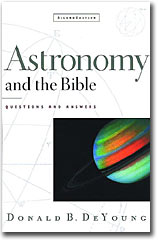 there's a good book here by Brian Young called, The Stars: God's Word in the Sky. You can get it from our ministry for $10.00. It's a great book on the stars. Christians shouldn't be afraid of astronomy. Now, astrology is different. But not, astronomy, God created everything. Here's a book, Astronomy and the Bible. I don't know if this one's available from our website or not, but we can get Donald B. DeYoung. It is, Jonathan? Yes, it is on our website. An awesome book. If you want to read more, because I think we should study astronomy, study what God has made. there's a good book here by Brian Young called, The Stars: God's Word in the Sky. You can get it from our ministry for $10.00. It's a great book on the stars. Christians shouldn't be afraid of astronomy. Now, astrology is different. But not, astronomy, God created everything. Here's a book, Astronomy and the Bible. I don't know if this one's available from our website or not, but we can get Donald B. DeYoung. It is, Jonathan? Yes, it is on our website. An awesome book. If you want to read more, because I think we should study astronomy, study what God has made.
 The zodiac The zodiac
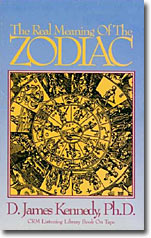 This book is a little controversial. D. James Kennedy, of Coral Ridge Ministries, Coral Ridge Presbyterian Church in Fort Lauderdale, Florida. He says, the zodiac, he goes through the 12 zodiac symbols and says probably these originally had a gospel story to them, which has now been perverted into the horoscope. So go to www.coralridge.org if you want to get the book, which is about $6.00 or $8.00. But the Bible does talk about the constellations. It talks about Pleiades and Orion in Job 38 (v. 31). And Mazzaroth and Arcturus in Job 38 (v. 32-33). There are constellations mentioned in the Bible. Now what does this mean? Now I don't know, and I don't know anybody who knows for sure, but here's what some Christians think. That when God originally made the world, Adam did not have a Bible, it hadn't been written yet. So God gave Adam the Gospel story in the stars. This book is a little controversial. D. James Kennedy, of Coral Ridge Ministries, Coral Ridge Presbyterian Church in Fort Lauderdale, Florida. He says, the zodiac, he goes through the 12 zodiac symbols and says probably these originally had a gospel story to them, which has now been perverted into the horoscope. So go to www.coralridge.org if you want to get the book, which is about $6.00 or $8.00. But the Bible does talk about the constellations. It talks about Pleiades and Orion in Job 38 (v. 31). And Mazzaroth and Arcturus in Job 38 (v. 32-33). There are constellations mentioned in the Bible. Now what does this mean? Now I don't know, and I don't know anybody who knows for sure, but here's what some Christians think. That when God originally made the world, Adam did not have a Bible, it hadn't been written yet. So God gave Adam the Gospel story in the stars. 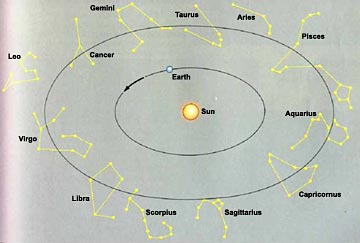 The twelve different constellations told the story of the redemption, the coming of Christ. And may be the Sphinx, this is one theory, the Sphinx by the pyramid, you know, in Egypt. They say the Sphinx was built to tell us how to read the Zodiac, because it starts with the face of a woman, and ends with the body of a lion. So you start reading the zodiac, instead of starting in January, like we do, you should start with Virgo, the virgin, and you go through the twelve constellations and end with Leo the lion. I don't know. I know today the horoscope is all perverted, and Satan always takes what God does and twists it, perverts it, and changes it. But if you want to study that, that's fine. There appears to be something to that though, that may be there really is something to this Gospel in the stars. And Carl Baugh has a good theory, that each of the constellations is producing different radio waves. Stars produce radio waves. He thinks the canopy of ice that used to be above the earth could actually change those radio frequencies into audible waves, like a crystal radio does; it would actually vibrate. And Adam and Eve would be able to hear the music of the stars mentioned in Job chapter 38. Whether that's true or not, I don't know, but it sure preaches good that the whole Gospel story was being sung to them continually as they traveled around every year. Who knows? The twelve different constellations told the story of the redemption, the coming of Christ. And may be the Sphinx, this is one theory, the Sphinx by the pyramid, you know, in Egypt. They say the Sphinx was built to tell us how to read the Zodiac, because it starts with the face of a woman, and ends with the body of a lion. So you start reading the zodiac, instead of starting in January, like we do, you should start with Virgo, the virgin, and you go through the twelve constellations and end with Leo the lion. I don't know. I know today the horoscope is all perverted, and Satan always takes what God does and twists it, perverts it, and changes it. But if you want to study that, that's fine. There appears to be something to that though, that may be there really is something to this Gospel in the stars. And Carl Baugh has a good theory, that each of the constellations is producing different radio waves. Stars produce radio waves. He thinks the canopy of ice that used to be above the earth could actually change those radio frequencies into audible waves, like a crystal radio does; it would actually vibrate. And Adam and Eve would be able to hear the music of the stars mentioned in Job chapter 38. Whether that's true or not, I don't know, but it sure preaches good that the whole Gospel story was being sung to them continually as they traveled around every year. Who knows?
 About the shrinking of the sun as evidence dat the sun is not billions of years old... About the shrinking of the sun as evidence dat the sun is not billions of years old...
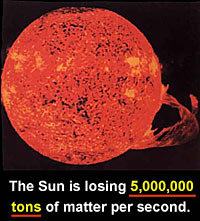 Anyway, second question: “Is the Sun shrinking?” There has been some controversy among creationist groups in the last 10 years over this question. The sun is shrinking. There is not much question about that, but does that prove it's not billions of years old? Well, I think so. The sun is burning obviously. You can step outside and look at it. It's losing about 5 million tons every second; quite a weight loss program. Well, that means of course, that it used to be bigger. You don't need to be too much of a genius to figure that out. Bulletin of American Astronomical Society ran an article back in ’79, which some people have argued about, the legitimacy of this. But they said: “Since 1836, more than one hundred different observers at the Royal Greenwich Observatory [that's in England] and the U.S. Naval Observatory have made direct, visual measurements that suggest the sun's diameter is shrinking at a rate of about 0.1% each century or about 5 feet (1.5 m) an hour.” Anyway, second question: “Is the Sun shrinking?” There has been some controversy among creationist groups in the last 10 years over this question. The sun is shrinking. There is not much question about that, but does that prove it's not billions of years old? Well, I think so. The sun is burning obviously. You can step outside and look at it. It's losing about 5 million tons every second; quite a weight loss program. Well, that means of course, that it used to be bigger. You don't need to be too much of a genius to figure that out. Bulletin of American Astronomical Society ran an article back in ’79, which some people have argued about, the legitimacy of this. But they said: “Since 1836, more than one hundred different observers at the Royal Greenwich Observatory [that's in England] and the U.S. Naval Observatory have made direct, visual measurements that suggest the sun's diameter is shrinking at a rate of about 0.1% each century or about 5 feet (1.5 m) an hour.” Let's assume that this is correct for the moment. If the sun is burning, and it's losing 5 feet an hour; that would be the diameter. So the radius would be losing 2½ feet (75 cm). It's 93 million miles (150 million km) to the earth. You divide that by 2½ feet per hour, you are going to find out it cannot possibly be billions of years old. That of course would assume several things. Has the rate always been the same? Has the rate of burn always been the same? Etcetera, etcetera... I know there are a lot of assumptions built in. Let's assume that this is correct for the moment. If the sun is burning, and it's losing 5 feet an hour; that would be the diameter. So the radius would be losing 2½ feet (75 cm). It's 93 million miles (150 million km) to the earth. You divide that by 2½ feet per hour, you are going to find out it cannot possibly be billions of years old. That of course would assume several things. Has the rate always been the same? Has the rate of burn always been the same? Etcetera, etcetera... I know there are a lot of assumptions built in. 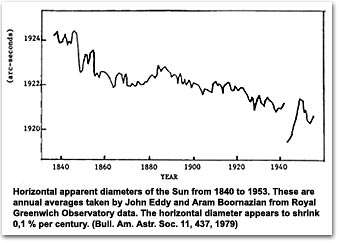 But I think we could all agree, the sun is burning. I think we could all agree it's getting smaller. “Several indirect techniques also confirm that the sun is shrinking, although these inferred about 1/7th as much.” But I think we could all agree, the sun is burning. I think we could all agree it's getting smaller. “Several indirect techniques also confirm that the sun is shrinking, although these inferred about 1/7th as much.” From Science magazine. Here's the chart showing the graph of what has been observed, written down. I mean, they look at the sun, they measure the diameter using trigonometry, and it's close enough to work that way. They measure the numbers and say: “Wow, the sun's diameter, polar and equatorial is shrinking.” Now I know the sun oscillates. It swells and contracts, and swells and contracts. It's burning, like a marshmallow, you know. But generally, you can see it from the graph, it is losing diameter, is losing size. From Science magazine. Here's the chart showing the graph of what has been observed, written down. I mean, they look at the sun, they measure the diameter using trigonometry, and it's close enough to work that way. They measure the numbers and say: “Wow, the sun's diameter, polar and equatorial is shrinking.” Now I know the sun oscillates. It swells and contracts, and swells and contracts. It's burning, like a marshmallow, you know. But generally, you can see it from the graph, it is losing diameter, is losing size.
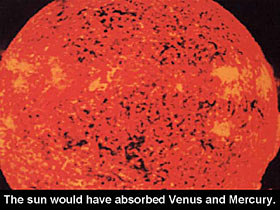 Well, if you go back billions of years, you would assume this would make a problem. If the sun were bigger, it would pretty soon absorb Mercury and then Venus and then Earth. I don't know how far back you'd have to go and I think Christians would be wise to not put a number on it. Don't say, well, you know, 18.6 million years ago, this would happen. Because what happens, the atheist then atheists argue about the number, and they miss the whole point. They miss the concept. The fact is, guys, it is burning. It used to be bigger. This creates a problem for your theory. A bigger problem, though, than just the size of the sun, is the mass. Well, if you go back billions of years, you would assume this would make a problem. If the sun were bigger, it would pretty soon absorb Mercury and then Venus and then Earth. I don't know how far back you'd have to go and I think Christians would be wise to not put a number on it. Don't say, well, you know, 18.6 million years ago, this would happen. Because what happens, the atheist then atheists argue about the number, and they miss the whole point. They miss the concept. The fact is, guys, it is burning. It used to be bigger. This creates a problem for your theory. A bigger problem, though, than just the size of the sun, is the mass. 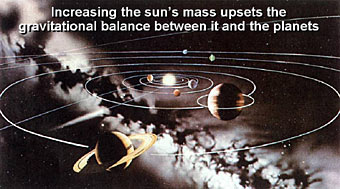 Gravity is directly proportional to how heavy the objects are, the mass of the object. If the sun were more massive, gravity would be stronger. And that is going to start sucking planets in, drawing them out of their orbits. So yes the sun is shrinking, and I think it creates a problem for those who want to believe that the universe is billions of years old. I wouldn't put a number on it, but it certainly makes a problem somewhere. Gravity is directly proportional to how heavy the objects are, the mass of the object. If the sun were more massive, gravity would be stronger. And that is going to start sucking planets in, drawing them out of their orbits. So yes the sun is shrinking, and I think it creates a problem for those who want to believe that the universe is billions of years old. I wouldn't put a number on it, but it certainly makes a problem somewhere.
Danny Faulkner is an astronomer at the University of South Carolina. He's a good friend of mine, and he's been down here to do some taping with us when I debated Hugh Ross. He's got a great article on his website. It's kind of long, but he says, “The young faint Sun paradox and the age of the solar system” by Danny Faulkner. Go to his website and read about that. But he says, because the sun, if you go back in time, would have been dimmer, this creates a problem. How can plants have survived with the changing brightness of the sun also? “Evolutionists maintain that life appeared on the earth about 3.8 billion years ago. Since then the Sun would have brightened 25%.” Well, if the sun is 25% brighter now than it was then, how could plants have evolved? He goes through some good legitimate points here. The ‘young faint Sun paradox’ is a problem for those who believe in evolution. He says, the logical conclusion he comes to is, it's not billions of years old. Of course, the other astronomers say that's not possible. Of course, you know, it's billions of years old. Of course it is. They don't like that idea. by Danny Faulkner. Go to his website and read about that. But he says, because the sun, if you go back in time, would have been dimmer, this creates a problem. How can plants have survived with the changing brightness of the sun also? “Evolutionists maintain that life appeared on the earth about 3.8 billion years ago. Since then the Sun would have brightened 25%.” Well, if the sun is 25% brighter now than it was then, how could plants have evolved? He goes through some good legitimate points here. The ‘young faint Sun paradox’ is a problem for those who believe in evolution. He says, the logical conclusion he comes to is, it's not billions of years old. Of course, the other astronomers say that's not possible. Of course, you know, it's billions of years old. Of course it is. They don't like that idea.
 About carbon dating (Carbon-14, C14)... About carbon dating (Carbon-14, C14)...
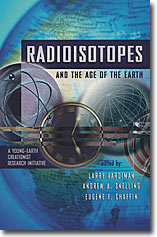 Ok, “What about carbon dating?” I get asked this question all the time. Jonathan spent $70.00 to get this book, alright, and the new one is out, and it's $80.00 now? $80.00. Radioisotopes and the Age of the Earth. The RATE Project, R-A-T-E. I am sure not the world's expert on carbon dating. But I think I can explain things. I am a teacher. I can explain it as best I can. That's what a teacher is supposed to do. Take the complex and explain it so that the average person can get it. Since I operate at about fourth grade level, you know, I have to understand it myself first, so I can explain it. Let me explain how carbon dating is supposed to work. And then tell you the serious problems with it. Carbon dating was not invented until 1949, in the last 60 years. So when they started telling the kids the earth is billions of years old, back in 1830, they didn't tell them because of carbon dating. They'd never thought of carbon dating. It had never been heard of. Why were they teaching the earth is billions of years old 160 years ago? Well, because they needed billions of years to make their theory look good. That's why. I mean, if I told you a frog would turn into a prince if you kissed it, you don't say, well... it's a fairy tale. But if I told you: “Hey kids, the frog can turn to the prince if you wait billions of years.” Oh wow, may be so, now it becomes believable. No, it's still a fairy tale. It's a stupid idea. Ok, “What about carbon dating?” I get asked this question all the time. Jonathan spent $70.00 to get this book, alright, and the new one is out, and it's $80.00 now? $80.00. Radioisotopes and the Age of the Earth. The RATE Project, R-A-T-E. I am sure not the world's expert on carbon dating. But I think I can explain things. I am a teacher. I can explain it as best I can. That's what a teacher is supposed to do. Take the complex and explain it so that the average person can get it. Since I operate at about fourth grade level, you know, I have to understand it myself first, so I can explain it. Let me explain how carbon dating is supposed to work. And then tell you the serious problems with it. Carbon dating was not invented until 1949, in the last 60 years. So when they started telling the kids the earth is billions of years old, back in 1830, they didn't tell them because of carbon dating. They'd never thought of carbon dating. It had never been heard of. Why were they teaching the earth is billions of years old 160 years ago? Well, because they needed billions of years to make their theory look good. That's why. I mean, if I told you a frog would turn into a prince if you kissed it, you don't say, well... it's a fairy tale. But if I told you: “Hey kids, the frog can turn to the prince if you wait billions of years.” Oh wow, may be so, now it becomes believable. No, it's still a fairy tale. It's a stupid idea.
 The geologic column The geologic column
 But the geologic column is where it all started. We covered that on video #4, and some more on video #6 about the geologic column. The earth was divided up into layers; Cenozoic, Mesozoic, Paleozoic, Archaeozoic, etc. Each layer was assigned a name, an age, and an index fossil. We covered that on video four. Then they said: “Now we have to prove these layers are old.” So they picked the numbers out of the clear blue sky and any dating technique that comes along, like carbon dating or any other, has to match the geologic column, or it's rejected. Only because the geologic column has been taught for 180 years now, so surely it's true. No, just because it's been taught 180 years doesn't make it true. But that's the logic the scientists will have. “Oh, we know the geologic column is established, therefore any carbon dates we get should match that. If they don't, we'll throw them out. And we'll keep testing till we do.” They may have to test a sample 5 or 6 times till they get the number they want. Well, how do you know any of them are right then, if you are getting a different number every time? How would you know that any of them are right? “Radiometric dating would not have been feasible, if the geologic column had not been erected first.” But the geologic column is where it all started. We covered that on video #4, and some more on video #6 about the geologic column. The earth was divided up into layers; Cenozoic, Mesozoic, Paleozoic, Archaeozoic, etc. Each layer was assigned a name, an age, and an index fossil. We covered that on video four. Then they said: “Now we have to prove these layers are old.” So they picked the numbers out of the clear blue sky and any dating technique that comes along, like carbon dating or any other, has to match the geologic column, or it's rejected. Only because the geologic column has been taught for 180 years now, so surely it's true. No, just because it's been taught 180 years doesn't make it true. But that's the logic the scientists will have. “Oh, we know the geologic column is established, therefore any carbon dates we get should match that. If they don't, we'll throw them out. And we'll keep testing till we do.” They may have to test a sample 5 or 6 times till they get the number they want. Well, how do you know any of them are right then, if you are getting a different number every time? How would you know that any of them are right? “Radiometric dating would not have been feasible, if the geologic column had not been erected first.” “Ever since William Smith at the beginning of the 19th century, fossils have been and still are the best and most accurate method of dating and correlating the rocks in which they occur. Apart from very ‘modern’ examples, which are really archaeology, I can think of no cases of radioactive decay being used to date fossils.” “Ever since William Smith at the beginning of the 19th century, fossils have been and still are the best and most accurate method of dating and correlating the rocks in which they occur. Apart from very ‘modern’ examples, which are really archaeology, I can think of no cases of radioactive decay being used to date fossils.” They don't date fossils by carbon dating. They date them by their geologic position. That's how it's done. They don't date fossils by carbon dating. They date them by their geologic position. That's how it's done.
 Carbon-14 principles Carbon-14 principles
But here is what happens. Earth's atmosphere is about 100 miles thick. A space shuttle, in order to get free from friction, has to get up about 100 miles outside the air. And you know, straight up, a hundred miles is not that far. It's from here, only halfway to Tallahassee, you know. But if you go up look at the atmosphere, it has very distinct layers to it, which is kind of interesting. It has a heat sink, where it gets very, very cold, up about seven or eight miles up. Like 80 or 90 or a 100 below zero.
- But the earth's atmosphere contains mostly nitrogen; 78% nitrogen, 21% oxygen, a little bit of CO2 for plants to breathe. Well, these don't breath, they're fake.
 Plants breathe in carbon dioxide, and there's a very little bit of radio-active Carbon-14, 0.0000765%. Plants breathe in carbon dioxide, and there's a very little bit of radio-active Carbon-14, 0.0000765%.
This radio-active Carbon-14 is different than regular carbon. It's produced by radiation striking the atmosphere. Sunlight strikes the atmosphere, slaps the nitrogen around and turns it into Carbon-14. So it all starts by the sunlight hitting the atmosphere, just to give you the procedure here. About 21 pounds (9 kg) of Carbon-14 is produced every year, and that is spread out all over the world. If I told you there are 21 pounds (9 kg) of gold, but it's spread out equally, all over the world, forget it, I'm not even going to go look for it. You're not going to find it. Real tiny amounts. If you look at the periodic table of elements, carbon and nitrogen are right next to each other. Nitrogen has an atomic weight of 14. Carbon has an atomic weight of 12. But if the sunlight slaps the nitrogen around, it'll knock a few things off of it, and it becomes Carbon-14. So it still weighs as much as the nitrogen, but now it is considered a carbon.
| |
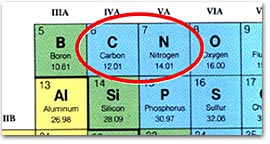 |
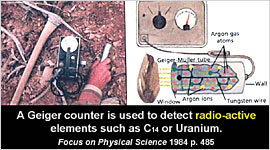 |
It's called radio-active, which does not mean it listens to the radio. It is just unstable, and it is going to break apart. It's like three guys dating the same girl, that relationship is not going to last, ok, forever. Something will go wrong. Find the one you want, Jonathan, just marry her and be happy the rest of your live, ok.  Carbon 14 is unstable. It does not like being carbon 14. It wants to get out of this situation, so it breaks down. About half of it will break down on a statistical average, about half of it is going to fall apart every 5,700 years. Now, it is doing this on a purely random procedure. I mean, you've got a pile of molecules. You never know which one is going to fall apart. But statistics tell us, about half of them will fall apart every 5,700 years, roughly. Now while it is carbon 14, it is floating around in the atmosphere. Like the rest of the carbon and it latches onto oxygen, like carbon often does and becomes carbon dioxide. And they hook up and they are happily floating around the atmosphere. And the plants are breathing in CO2. Animals come along and eat the plants. Carbon 14 is unstable. It does not like being carbon 14. It wants to get out of this situation, so it breaks down. About half of it will break down on a statistical average, about half of it is going to fall apart every 5,700 years. Now, it is doing this on a purely random procedure. I mean, you've got a pile of molecules. You never know which one is going to fall apart. But statistics tell us, about half of them will fall apart every 5,700 years, roughly. Now while it is carbon 14, it is floating around in the atmosphere. Like the rest of the carbon and it latches onto oxygen, like carbon often does and becomes carbon dioxide. And they hook up and they are happily floating around the atmosphere. And the plants are breathing in CO2. Animals come along and eat the plants.
- So the only way Carbon-14 gets into the living world is this way. It is produced by the sun, striking the atmosphere, plants breathe it in, animals eat the plants.
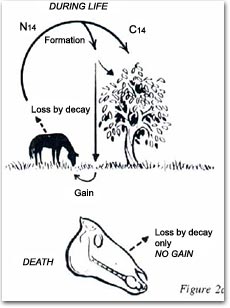 Probably during your lifetime, you've either eaten plants or you've eaten animals that have eaten plants. How many of you have ever done that before? Like today for lunch right, ok. Everything we do is from one of those 2 sources, it is plants or animals that eat plants. Well, the plants are absorbing CO2. Some of it is radioactive. Probably during your lifetime, you've either eaten plants or you've eaten animals that have eaten plants. How many of you have ever done that before? Like today for lunch right, ok. Everything we do is from one of those 2 sources, it is plants or animals that eat plants. Well, the plants are absorbing CO2. Some of it is radioactive.
- So if the atmosphere contains .0000765%, it is assumed that the plants also have .0000765%.
Probably a reasonable assumption, and I don't argue with them. I just point out that this is one of dozens of assumptions, that can enter in to really mess up things like carbon dating. So probably you have .0000765% carbon in you, because you've been eating these plants or you have been eating these animals, which have been eating these plants. Probably it's all balanced in nature.
- When the plant or animal dies, it stops eating, taking in more C14. It stops breathing, ok.
Now whatever it had is going to decay. It was decaying while it was alive. But now there is nothing to replace it.
- So what they do is they compare the amount of C14 in the fossil with the amount in the atmosphere and say: “Wow, this fossil has only got half as much, therefore, it has been dead for one half life, 5,700 years.” Because it continues to decay after it died, but now it can't be replaced.

So while it was alive, it should have had about 0.0000765%. If it only has 0.00003825% it's been dead for one half life. Or two half-lives or three half-lives, etc. In theory it never goes to zero. But for practical purposes, you can't measure beyond a certain amount. You know, you're going to run out of stuff to measure. It goes from a ½ to a ¼ to a ⅛ to a 1/16 to ...not enough to measure.
 Observed limitations of the method Observed limitations of the method
A great article came out from the Institute for Creation Research (ICR). They are the ones who did the RATE project, www.icr.org. They said: “With their short 5,700-year half-life, no carbon 14 atoms should exist in any carbon older than 250,000 years. [It should all be gone.] Yet it has proven impossible to find any natural source of carbon below the ice age (Pleistocene) that does not contain significant amounts of Carbon-14, even though such strata are supposed to be millions or billions of years old. Conventional Carbon-14 laboratories have been aware of this anomaly since the early 1980s, and have striven to eliminate it, and are unable to account for it. Lately the world's best such laboratory which has learned during two decades of low-C14 measurements how not to contaminate specimens externally, under contract to creationists, they confirmed such observations for coal samples and even for a dozen diamonds.” Now, think what that means. The textbooks will tell you coal formed 250 million years ago in the Carboniferous Era. And yet when they test coal, it still has Carbon-14. How is that possible? If all the Carbon-14 atoms would have disappeared in say 30, 40, 50,000 years, why would there still be Carbon-14 atoms in coal? I got an idea..., it's not a quarter million years old? Oh, they don't like that answer. They'll keep searching until they find another answer, because they don't like that one, for sure. And diamonds, which they say formed millions and millions of years ago, you know, they still have Carbon-14 in them and it's not possible to contaminate one of those things. I mean, it's the hardest substance we have. So how do you get Carbon-14 in diamonds? And when did diamonds form? Well, I'm not sure when diamonds formed. I know Superman makes them in a few minutes. You know, he takes a piece of coal, squeezes it to give to, what's her name, you know, Olive Oyl... But they learned today, just in the last 20 years, I guess, how to make diamonds that are just indistinguishable from natural diamonds. High pressure, they've been doing it for years, making artificial diamonds, but they can't get them very big. Now, just, I think in 2005, they were able to make big diamonds with this synthetic process. [comments from a person in the public...] Take your pet, that's right; burn the body; cremate it; pressure it into a diamond. You can wear your dog the rest of your life, you know. Your ex-wife..., I don't think I want to do that. We were talking about that on the radio yesterday. 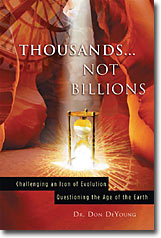 Anyway, this guy says even these diamonds have Carbon-14. He says they “cannot be contaminated. These constitute very strong evidence that the earth is only thousands, not billions of years old.” Anyway, this guy says even these diamonds have Carbon-14. He says they “cannot be contaminated. These constitute very strong evidence that the earth is only thousands, not billions of years old.”
Now the RATE project book (from ICR) is difficult reading, heavy reading. Jonathan, you're awfully smart. How far did you make it through the book? About half way and it's taken you almost a year? Yes, it is heavy reading. If you want the simplified, don't go down quite so deep version, this one is excellent by Donald B. DeYoung, Thousands, Not Billions. He kind of summarizes in real English what they said, different ways to show; look, it is not billions of years old.
 Assumptions of the method Assumptions of the method
But the carbon dating assumptions need to be pointed out. They'll say: “Well, we know carbon decays at a certain rate and so we know it's only got half as much, as half as old.” There are some assumptions that mess up everything. I'll show you how it works. If I said: “We're going to fill a barrel with water,” so I hand Lea the hose. “Here Lea, fill this with water.” 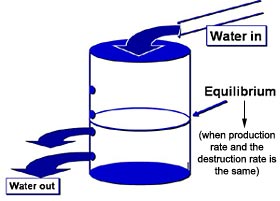 But what you don't know is that I have drilled holes in the barrel. While you're putting it in, the water is leaking out. It's kind of like your checkbook, you know. You keep putting it in and it keeps leaking out someplace, right, how many of you have discovered that. You got a ring, Jonathan, you are discovering it now, right. Well, the earth's atmosphere is kind of like this barrel. It's always getting brand new Carbon-14. 21 pounds every year being put in, and it's always leaking out through decay. So the question would be, how long would it take to reach a stage called equilibrium? Now with a barrel, you can actually do the math and calculate, if I'm gonna put in a certain amount of water per minute and a certain amount per minute leaks out, when will I reach equilibrium, and where... this can all be calculated, you know, with a little bit of math. And with the atmosphere, they said: “When will the atmosphere reach equilibrium?” So, the guys who invented carbon dating in the late ’40s said: “I wonder about this Earth's atmosphere reaching equilibrium.” They did a bunch of studies on that, and said: “Now, if we took a brand new planet earth, created it from scratch, and got it going around the sun, how long would it take to reach this equilibrium point in the atmosphere where the production rate and the destruction rate is the same?” And they determined it would take about 30,000 years to reach equilibrium. I'm not sure how they did all that, you can probably see some RATE scientist and figure it out. Then they made two mistakes, in my totally unbiased opinion. They said: But what you don't know is that I have drilled holes in the barrel. While you're putting it in, the water is leaking out. It's kind of like your checkbook, you know. You keep putting it in and it keeps leaking out someplace, right, how many of you have discovered that. You got a ring, Jonathan, you are discovering it now, right. Well, the earth's atmosphere is kind of like this barrel. It's always getting brand new Carbon-14. 21 pounds every year being put in, and it's always leaking out through decay. So the question would be, how long would it take to reach a stage called equilibrium? Now with a barrel, you can actually do the math and calculate, if I'm gonna put in a certain amount of water per minute and a certain amount per minute leaks out, when will I reach equilibrium, and where... this can all be calculated, you know, with a little bit of math. And with the atmosphere, they said: “When will the atmosphere reach equilibrium?” So, the guys who invented carbon dating in the late ’40s said: “I wonder about this Earth's atmosphere reaching equilibrium.” They did a bunch of studies on that, and said: “Now, if we took a brand new planet earth, created it from scratch, and got it going around the sun, how long would it take to reach this equilibrium point in the atmosphere where the production rate and the destruction rate is the same?” And they determined it would take about 30,000 years to reach equilibrium. I'm not sure how they did all that, you can probably see some RATE scientist and figure it out. Then they made two mistakes, in my totally unbiased opinion. They said:
- “Number one, we know the earth is millions years old.” Mistake number one.
- “Number two,” they said, “we can ignore the equilibrium problem, because we would have passed that point 30,000 years ago.”
And do you know, they have discovered that the earth has still not reached equilibrium. “Radiocarbon is still forming 30 to 40% faster than it's decay.” Now think about that, if radiocarbon is still forming faster than it is decaying, that means the earth is less than 30,000 years old, number one. And number two, you can't carbon date anything, because you would have to know when it lived, so that you could calculate when it lived. You have to know already when it lived to know how much Carbon-14 it was breathing at that time. Now think about that, if radiocarbon is still forming faster than it is decaying, that means the earth is less than 30,000 years old, number one. And number two, you can't carbon date anything, because you would have to know when it lived, so that you could calculate when it lived. You have to know already when it lived to know how much Carbon-14 it was breathing at that time. 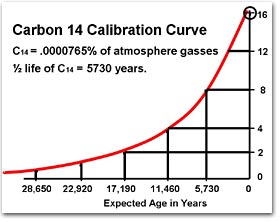 It doesn't work. There's a website, www.arky.org, he's got more stuff on the earth has not reached equilibrium, you got some articles there by Ron Cooper. But this is a calibration curve. If an animal is still alive, it should give you about 16 clicks on your Geiger counter per minute per gram. If you're only getting eight, you say it's been through one half-life or four clicks, two half-lives, three half-lives, etc. This is called the calibration curve. In theory it sounds like it should work. But there are several real obvious assumptions. I don't know how they don't see it. It doesn't work. There's a website, www.arky.org, he's got more stuff on the earth has not reached equilibrium, you got some articles there by Ron Cooper. But this is a calibration curve. If an animal is still alive, it should give you about 16 clicks on your Geiger counter per minute per gram. If you're only getting eight, you say it's been through one half-life or four clicks, two half-lives, three half-lives, etc. This is called the calibration curve. In theory it sounds like it should work. But there are several real obvious assumptions. I don't know how they don't see it.
Suppose you walked into a room, and I said: “I want you to tell me..., here's this candle burning on a table, when was it lit.” You find out it was seven inches tall. You say: “Well, that won't tell me anything.” Now we've got to measure how fast it was burning. We measure the candle for awhile. We get an Olympic stopwatch, and we get it down to the nearest 40th bazillionth of a second, ok. And we all agree the candle is burning an inch an hour. Here's our two facts:
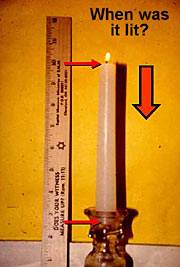 Seven inches (18 cm) tall. Seven inches (18 cm) tall. - Burning an inch (2½ cm) an hour.
When was it lit? Nobody can figure it out, unless you make some assumptions.
- Assumption number one; how tall was the candle?
- And assumption number two; has it always burned at the same rate?
Neither of those can be known. If you find a fossil in the dirt, the amount of carbon can be measured, and the rate of decay can be determined. We don't argue with either of those.
- How much was in it when it lived? I don't know.
- Has it always decayed at the same rate? I don't know.
- Has it been contaminated sitting in the ground for all these millions of years?
There's no way to know those things. If the earth had a canopy of water above the atmosphere, or a canopy of ice as we cover in seminar #2, that would have blocked out a lot of radiation from the Sun which would have prevented most of the Carbon-14 from even forming. So animals that lived before the flood would have lived in a world with much less Carbon-14 to begin with, maybe none, but certainly less. And when we dig up the fossil that's been buried for 4,400 years, let's say it started with four, whereas today we start with 16. We dig it up 4,400 years after the flood and say: “Wow, here's a mammoth that got buried, and it's carbon dated.” Oh, we're assuming it started at 16. When we test it and find it's got two. We think it's been through four half-lives, when it's actually only been through one half-life. Which is why it never works.
 Dubious practices! Dubious practices!
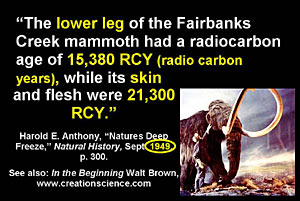 When they first invented carbon dating in 1949, William Libby did some testing and they said: “The lower leg of a mammoth was 15,000 years old, but the skin was 21,000.” How can two parts of the same animal be different ages? Quite obviously, we know one of the numbers is wrong. So how would you know either of them are right? And if either one is right, how would you know which one? I see no way to tell. Well, let's see if it is getting better. When they first invented carbon dating in 1949, William Libby did some testing and they said: “The lower leg of a mammoth was 15,000 years old, but the skin was 21,000.” How can two parts of the same animal be different ages? Quite obviously, we know one of the numbers is wrong. So how would you know either of them are right? And if either one is right, how would you know which one? I see no way to tell. Well, let's see if it is getting better. - Fourteen years [1963] later they tested a living mollusk, a clam, and it was 2,300 years old. It was still alive.

- In 1970, at the Nobel Symposium they said: “If a C14 date supports our theories, we put it in the main text. If it does not entirely contradict them, we put it in a footnote. And if it is completely ‘out of date’, we just drop it.”
 You mean they can pick and choose any numbers they want? Exactly correct. If the number doesn't fit what they expected, they throw the number out. You mean they can pick and choose any numbers they want? Exactly correct. If the number doesn't fit what they expected, they throw the number out.
 In 1971, a freshly killed seal was 1,300 years old when they carbon dated it. In 1971, a freshly killed seal was 1,300 years old when they carbon dated it. - “The troubles of radiocarbon dating are undeniably deep and serious. Despite 35 years of technological refinement and better understanding, the underlying assumptions have been strongly challenged and warnings are out that radiocarbon dating my soon find itself in a crisis situation. Continuing use of the method depends on a ‘fix-it-as-we-go’ approach, allowing for contamination here, fractionation there, and calibration whenever possible. It should be no surprise then, that fully half the dates are rejected.”
 Did you follow that? Out of thousands of carbon dates, that have been carbon dating, times that they have done it, half of the numbers are thrown out. How do they know they are wrong? And also how would you know the other half is right? If half your test results have to be thrown out, it ought to raise red flags in somebody's brain. Wait a minute, this is stupid. What are we doing? We're wasting our time here. And the article goes on to say: “The wonder is, surely, that the remaining half have come to be accepted. No matter how ‘useful’ it is, the radiocarbon method is still not capable of yielding accurate and reliable results. There are gross discrepancies.The chronology is uneven, relative and the accepted dates are actually selected dates. Did you follow that? Out of thousands of carbon dates, that have been carbon dating, times that they have done it, half of the numbers are thrown out. How do they know they are wrong? And also how would you know the other half is right? If half your test results have to be thrown out, it ought to raise red flags in somebody's brain. Wait a minute, this is stupid. What are we doing? We're wasting our time here. And the article goes on to say: “The wonder is, surely, that the remaining half have come to be accepted. No matter how ‘useful’ it is, the radiocarbon method is still not capable of yielding accurate and reliable results. There are gross discrepancies.The chronology is uneven, relative and the accepted dates are actually selected dates. 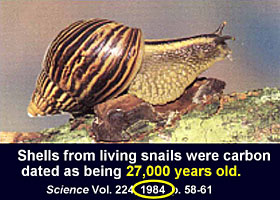 This whole blessed thing is nothing but 13th Century alchemy.” And I agree. That's 1981. I've got all these in chronological order. It never gets better. This whole blessed thing is nothing but 13th Century alchemy.” And I agree. That's 1981. I've got all these in chronological order. It never gets better.
- 1984, living snails carbon dated 27,000 years old.
- 1992, two mammoths found side by side. They carbon date them. One is 22,000. The other is 16,000. Which one's right? Or are both of them wrong? Or are both of them right? There is no possible way to tell.

 Guessing and fitting... Guessing and fitting...
- “In 1996, Carl Swisher at Berkeley University used the most advanced techniques to date human fossils. Last spring he was re-evaluating Homo erectus skulls found in Java in the 1930s. He was testing the sediment found with them. The species was supposed to be extinct for a ¼ of a million years. Swisher used two different dating methods, he kept making the same startling find: the bones were 53,000 years old at most and possibly no more than 27,000.”
 I'd like to point out two things here. He's looking for ¼ million as his answer. But he keeps getting 53 to 27 thousand, ok, which is only one fifth of what he wants. But he's still getting a 96% error. I mean, is it 27,000 or 53,000? This is not an exact science! I'd like to point out two things here. He's looking for ¼ million as his answer. But he keeps getting 53 to 27 thousand, ok, which is only one fifth of what he wants. But he's still getting a 96% error. I mean, is it 27,000 or 53,000? This is not an exact science!
So when they publish an article in the paper and say: “We found a dinosaur bone or mammoth bone, and it was, you know, 17,221 years old and 6 months and 3 days.” Right, come on, you don't know that. They're making up this stuff. They are just absolutely making it up.
- Professor Reiner Protsch von Zieten in February of 2005 resigned as a professor because he had been lying about carbon dating for years. His frauds were exposed in
 February of 2005. He had dated the ‘Bischof-Speyer’ skeleton at 21,300 years old, but when they tested it at Oxford, they said it was only 3,300 years old. February of 2005. He had dated the ‘Bischof-Speyer’ skeleton at 21,300 years old, but when they tested it at Oxford, they said it was only 3,300 years old. 700% error. Professor Protsch said he had found the oldest German to ever move to Germany, 27,400 years old. They tested it at Oxford and said this was an old man who died in 1750. He's 250 years old. This professor had been lying about this stuff for decades, and so he finally resigned in disgrace. Well, he should, ok. 700% error. Professor Protsch said he had found the oldest German to ever move to Germany, 27,400 years old. They tested it at Oxford and said this was an old man who died in 1750. He's 250 years old. This professor had been lying about this stuff for decades, and so he finally resigned in disgrace. Well, he should, ok.
- [1975] “One part of a mammoth dated 29,500 years old and another part was 44,000.”
 You talk about a slow birth. That would be it, ok. You talk about a slow birth. That would be it, ok.
- [1975] I like this article obtained from Rand McNally. “The last two years an absolute date was obtained for (the Ngandong beds, above the Trinil beds) [that is in Indonesia], and it has the very interesting value of 300,000 years plus or minus 300,000 years.”
 Boy, they nailed that right on the head, didn't they, plus or minus, you know; 100% error. Boy, they nailed that right on the head, didn't they, plus or minus, you know; 100% error.
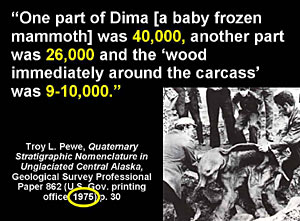 [1975] In the Geological Survey Professional Paper 862, and I get some flack over this, but I've got the paper in the library somewhere. We couldn't find it here. There are all kinds of articles about carbon dating of things in Alaska. I just want to show you a few things here. They carbon dated sample #SI454. See that on the chart there and said it was 17,210 years plus or minus 500. Then they tested sample #SI455 and said: “It's 24,140 years old.” Well, 17,000, or 24,000, you say that's looking good until you find out that's the same sample as 454. Very same sample, tested again. So is it 17,000 or 24,000? Sample #299 was less than 20,000 years old. That little carat means less than. Sample #L136 is greater than 28,000. You say: “Well, that's working good.” This sample is less than 20,000 and that other sample is more than 28,000, until you find out it's the same sample as #299. How can a sample be less than 20 and greater than 28 at the same time? I taught algebra for a long time, and I don't think you can do such a thing. That's not too good. [1975] In the Geological Survey Professional Paper 862, and I get some flack over this, but I've got the paper in the library somewhere. We couldn't find it here. There are all kinds of articles about carbon dating of things in Alaska. I just want to show you a few things here. They carbon dated sample #SI454. See that on the chart there and said it was 17,210 years plus or minus 500. Then they tested sample #SI455 and said: “It's 24,140 years old.” Well, 17,000, or 24,000, you say that's looking good until you find out that's the same sample as 454. Very same sample, tested again. So is it 17,000 or 24,000? Sample #299 was less than 20,000 years old. That little carat means less than. Sample #L136 is greater than 28,000. You say: “Well, that's working good.” This sample is less than 20,000 and that other sample is more than 28,000, until you find out it's the same sample as #299. How can a sample be less than 20 and greater than 28 at the same time? I taught algebra for a long time, and I don't think you can do such a thing. That's not too good. - “Living penguins were dated as 8,000 years old.”
 Dating results guided by preconceptions; The shell game Dating results guided by preconceptions; The shell game
 [1972] “Material from layers where dinosaur bones were found were carbon dated at 34,000 years old.” [1972] “Material from layers where dinosaur bones were found were carbon dated at 34,000 years old.”
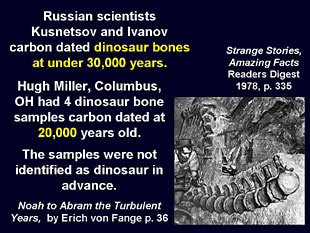 I was in a debate one time, and this professor was getting so upset. Finally, he said: “How can you use ‘Reader's Digest’ as a resource?” I said: “Sir, I use the ‘Reader's Digest’ as a resource for the picture of the dinosaur bone. It's not the resource for the fact, ok. That's where I got the picture from.” - “Oh, ok, ok,” and we went on with the debate. But yes, dinosaurs are today 70 million years old. A Russian scientist dated dinosaur bones at less than 30,000 years old. Hugh Miller from Columbus, Ohio took in four dinosaur bone samples and said: “Will you carbon date these?” And they charge like $600.00 to carbon date something. They carbon dated them and said they are less than 20,000 years old. He said: “Oh, by the way, these are dinosaur bones.” They said: “Oh, then they're not 20,000. We've got to test them again.” Why can't they be 20,000? They said: “Well, we know dinosaurs lived 70 million years ago, so if you had told us that, we never would have carbon dated them.” One friend of mine, died here several years ago, but he was digging and doing a lot of archaeological work. And he dug down in this well and he found layers of burned wood, which is good to carbon date, because obviously, you know, it had carbon in it. And he put it in bag, labeled it Sample A from such and such a layer and however many feet down, he labeled it A. He dug down ten or 20 more feet (3 to 6 m), found another layer of burned wood. (A city had been destroyed.) He labeled that one Sample B. He took them in to have them carbon dated. He paid them $600.00. They said Sample A is, I forget, 3,000 years old and this one is 4,000 years old. He waited 6 months, switched the labels, took them back into the same laboratory, and said, I want you to carbon date these samples. Now, sample B, the lower one, is in the top bag, just switched the label sand he's been given the same results, 3,000 and 4,000. It doesn't work. It has never worked. I was in a debate one time, and this professor was getting so upset. Finally, he said: “How can you use ‘Reader's Digest’ as a resource?” I said: “Sir, I use the ‘Reader's Digest’ as a resource for the picture of the dinosaur bone. It's not the resource for the fact, ok. That's where I got the picture from.” - “Oh, ok, ok,” and we went on with the debate. But yes, dinosaurs are today 70 million years old. A Russian scientist dated dinosaur bones at less than 30,000 years old. Hugh Miller from Columbus, Ohio took in four dinosaur bone samples and said: “Will you carbon date these?” And they charge like $600.00 to carbon date something. They carbon dated them and said they are less than 20,000 years old. He said: “Oh, by the way, these are dinosaur bones.” They said: “Oh, then they're not 20,000. We've got to test them again.” Why can't they be 20,000? They said: “Well, we know dinosaurs lived 70 million years ago, so if you had told us that, we never would have carbon dated them.” One friend of mine, died here several years ago, but he was digging and doing a lot of archaeological work. And he dug down in this well and he found layers of burned wood, which is good to carbon date, because obviously, you know, it had carbon in it. And he put it in bag, labeled it Sample A from such and such a layer and however many feet down, he labeled it A. He dug down ten or 20 more feet (3 to 6 m), found another layer of burned wood. (A city had been destroyed.) He labeled that one Sample B. He took them in to have them carbon dated. He paid them $600.00. They said Sample A is, I forget, 3,000 years old and this one is 4,000 years old. He waited 6 months, switched the labels, took them back into the same laboratory, and said, I want you to carbon date these samples. Now, sample B, the lower one, is in the top bag, just switched the label sand he's been given the same results, 3,000 and 4,000. It doesn't work. It has never worked.
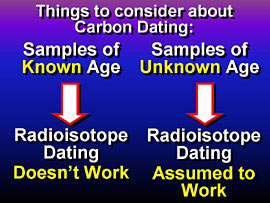 Here are some things to consider about carbon dating. When you date a sample of known age; it doesn't work. If you date a sample of unknown age; it is assumed to work. That's not science, ok. As things decay, they produce helium. This helium, the amount of helium in the atmosphere is only enough to account for a few thousand or a few million years, not billions of years. Here are some things to consider about carbon dating. When you date a sample of known age; it doesn't work. If you date a sample of unknown age; it is assumed to work. That's not science, ok. As things decay, they produce helium. This helium, the amount of helium in the atmosphere is only enough to account for a few thousand or a few million years, not billions of years. There's a book called The Mythology of Modern Dating Methods by ICR [www.icr.org], if you want to read up on that. There's a book called The Mythology of Modern Dating Methods by ICR [www.icr.org], if you want to read up on that. 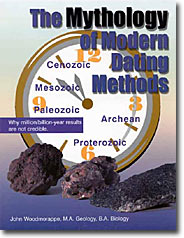 They do a lot of testing on this. They are probably the experts on this in the creation community. This guy said: “The rocks do date the fossils, but the fossils date the rocks more accurately.” They do a lot of testing on this. They are probably the experts on this in the creation community. This guy said: “The rocks do date the fossils, but the fossils date the rocks more accurately.” That's ludicrous and it's based on circular reasoning. They have known that for centuries. We cover more on that in video #4. I talked to James P. Dawson. He's going to be on our radio program, tonight actually, he is supposed to call in. James Dawson was one of the guys working on dating the moon rocks. They brought back moon rocks, gave them to his laboratory, and said: “How old is the moon rock?” He took specimen #10017, divided it into six pieces and tested it many, many times. How old is it? They got numbers ranging from 2.5 billion to 4.6 billion. That's a 100% error. That's ludicrous and it's based on circular reasoning. They have known that for centuries. We cover more on that in video #4. I talked to James P. Dawson. He's going to be on our radio program, tonight actually, he is supposed to call in. James Dawson was one of the guys working on dating the moon rocks. They brought back moon rocks, gave them to his laboratory, and said: “How old is the moon rock?” He took specimen #10017, divided it into six pieces and tested it many, many times. How old is it? They got numbers ranging from 2.5 billion to 4.6 billion. That's a 100% error. 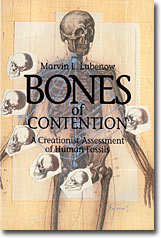 I talked to him back in 1999. He's in Oklahoma, and there is his phone number. He was the Chief of Engineering and Operations for the Lunar and Earth Science Division of the Manned Spacecraft Center for NASA in Houston. He worked on Lunar samples including the Genesis rock. He told me they found ages from 10,000 years to several billion in the same rock. His website is, www.jpdawson.com. How can one rock be 10,000 years old and several billion years old at the same time? Something is wrong, ok. The book, Bones of Contention has a great chapter at the end called, “The Dating Game” showing how that they will just change the dates whenever necessary. If it doesn't fit the theory, oh, let's test it again, until it fits the theory. See, the theory is important. The facts are not. Evolution as I have said many times, is a carefully protected state religion. And that's all it is. I talked to him back in 1999. He's in Oklahoma, and there is his phone number. He was the Chief of Engineering and Operations for the Lunar and Earth Science Division of the Manned Spacecraft Center for NASA in Houston. He worked on Lunar samples including the Genesis rock. He told me they found ages from 10,000 years to several billion in the same rock. His website is, www.jpdawson.com. How can one rock be 10,000 years old and several billion years old at the same time? Something is wrong, ok. The book, Bones of Contention has a great chapter at the end called, “The Dating Game” showing how that they will just change the dates whenever necessary. If it doesn't fit the theory, oh, let's test it again, until it fits the theory. See, the theory is important. The facts are not. Evolution as I have said many times, is a carefully protected state religion. And that's all it is.
 About potassium-argon dating (K-Ar)... About potassium-argon dating (K-Ar)...
 “What about potassium-argon (K-Ar) dating? Does that work?” Actually, the numbers are bigger, but the problems and assumptions are exactly the same. And you can demonstrate it doesn't work. Potassium decays very slowly. This chart shows the different elements and their half-lives. Carbon has a half-life of around 5,700 years, but potassium it takes 1.3 billion years, with a ‘b’, for half of that to disappear. It very slowly decays. By the way, I would like to point out, Your Honor, just for, you know, appeal, that all the dating methods are based on the decay of an element. Uranium decays to lead. Potassium decays to argon. They are all moving down the Periodic Table; not up. All going down. Just point out, keep that in mind in case we need to appeal this case, alright. “80% of the potassium in a small sample of an iron meteorite can be removed by distilled water in 4½ hours.” “What about potassium-argon (K-Ar) dating? Does that work?” Actually, the numbers are bigger, but the problems and assumptions are exactly the same. And you can demonstrate it doesn't work. Potassium decays very slowly. This chart shows the different elements and their half-lives. Carbon has a half-life of around 5,700 years, but potassium it takes 1.3 billion years, with a ‘b’, for half of that to disappear. It very slowly decays. By the way, I would like to point out, Your Honor, just for, you know, appeal, that all the dating methods are based on the decay of an element. Uranium decays to lead. Potassium decays to argon. They are all moving down the Periodic Table; not up. All going down. Just point out, keep that in mind in case we need to appeal this case, alright. “80% of the potassium in a small sample of an iron meteorite can be removed by distilled water in 4½ hours.” Well, if you can take out 80% of it in 4½ hours, how can you trust any of the dates you're going to obtain by that? The Canadian Journal of Earth Science run an article and said: “In conventional interpretation of Potassium-Argon age, it is common to discard ages which are substantially too high or too low compared to the rest of the group or with other available data such as the geological time scale.” Well, if you can take out 80% of it in 4½ hours, how can you trust any of the dates you're going to obtain by that? The Canadian Journal of Earth Science run an article and said: “In conventional interpretation of Potassium-Argon age, it is common to discard ages which are substantially too high or too low compared to the rest of the group or with other available data such as the geological time scale.” There it is. If you test a sample, and the number is too high or too low or it doesn't match the geologic column, it gets thrown out. Well, then why are you wasting your time and money testing it? You already know how old you'd like it to be, give it a number. Pick a number. It's dumb. There it is. If you test a sample, and the number is too high or too low or it doesn't match the geologic column, it gets thrown out. Well, then why are you wasting your time and money testing it? You already know how old you'd like it to be, give it a number. Pick a number. It's dumb.
 Potassium-argon principles Potassium-argon principles
The KBS Tuff ; a ‘tuff’ is a layer of ash or lava, generally ash that has been packed and turned into rock, it's called tuff, t-u-f-f. Kay Behrensmeyer had been dating these samples with potassium-argon (K-Ar) dating. So here's the theory, when a volcano erupts, the rocks and stuff coming out are really hot and any gases in it should be able to escape. Well, potassium (K, a mineral) slowly turns into argon (Ar), and argon is a gas. They use it for welding over at the shop; argon welding, you know. Argon is a gas. So since potassium turns to argon. 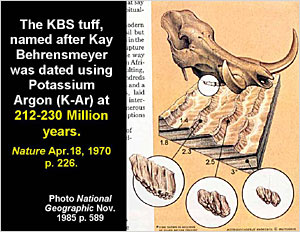 When the rock gets melted and shot out of a volcano, all the gas escapes. And so the theory says, this new layer should have been..., the clock is now reset. It is zero years old. Even though when it was in the earth, it's, you know, 4 billion years old, now all the argon is gone, because it accumulated this argon for millions of years, but now pooof, it melted and the gas is gone. So, we can potassium-argon date this lava or ash or any volcanic material. Well, they had been dating this layer of ash, named after Kay Behrensmeyer, because she did research on them [KBS = Kay Behrensmeyer Site]. They said it's 212 to 230 million years old. All the scientists agreed that layer of ash is around 200 million years old. When the rock gets melted and shot out of a volcano, all the gas escapes. And so the theory says, this new layer should have been..., the clock is now reset. It is zero years old. Even though when it was in the earth, it's, you know, 4 billion years old, now all the argon is gone, because it accumulated this argon for millions of years, but now pooof, it melted and the gas is gone. So, we can potassium-argon date this lava or ash or any volcanic material. Well, they had been dating this layer of ash, named after Kay Behrensmeyer, because she did research on them [KBS = Kay Behrensmeyer Site]. They said it's 212 to 230 million years old. All the scientists agreed that layer of ash is around 200 million years old. 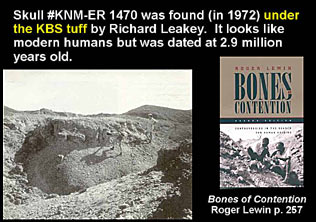 Until Richard Leakey came along in 1972. And he's digging around under the KBS Tuff, and he finds a perfectly normal human skull. Everybody panics and says: “How can you have a normal human skull under 200 million year old rock, when man didn't even evolve till like 3 million years ago? That's not possible.” And so they looked for things like, was this a burial site, did someone dig through and bury this person down here? Was there an earthquake? Is there a fault line near here someplace? No. All they could conclude is there was a normal human skull under 200 million year old rock. So what do you conclude? One group studied this and said: “Well, that proves aliens came here 200 million years ago.” Would you just consider that maybe the rock is not 200 million years old? After they found out that it could not be an intrusion, or a burial or anything else, it had to be legitimately placed there, I mean it was buried under this ash layer, they took 10 more samples of the KBS Tuff and dated them again. Keep in mind they had already dated them a bunch of times, and everybody agreed it was 212 million years old. But now they take ten more samples and checked them again and say: “Oh, no, it's only 0.5 to 2.6 million.” Until Richard Leakey came along in 1972. And he's digging around under the KBS Tuff, and he finds a perfectly normal human skull. Everybody panics and says: “How can you have a normal human skull under 200 million year old rock, when man didn't even evolve till like 3 million years ago? That's not possible.” And so they looked for things like, was this a burial site, did someone dig through and bury this person down here? Was there an earthquake? Is there a fault line near here someplace? No. All they could conclude is there was a normal human skull under 200 million year old rock. So what do you conclude? One group studied this and said: “Well, that proves aliens came here 200 million years ago.” Would you just consider that maybe the rock is not 200 million years old? After they found out that it could not be an intrusion, or a burial or anything else, it had to be legitimately placed there, I mean it was buried under this ash layer, they took 10 more samples of the KBS Tuff and dated them again. Keep in mind they had already dated them a bunch of times, and everybody agreed it was 212 million years old. But now they take ten more samples and checked them again and say: “Oh, no, it's only 0.5 to 2.6 million.” Well, that's way down from 212. They dropped the number way down, but they're still getting over a 500% error, from 0.5 to 2.6. This is not an exact science. Well, that's way down from 212. They dropped the number way down, but they're still getting over a 500% error, from 0.5 to 2.6. This is not an exact science.
 The earth is getting older and older, faster and faster; Dubious practices The earth is getting older and older, faster and faster; Dubious practices
- See, back in 1770 they taught the earth was 70,000 years old.

- In 1905 they said it's 2 billion years old.

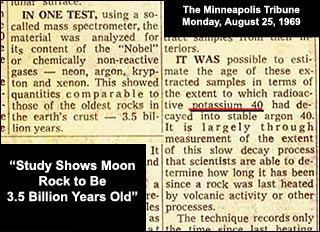 By 1969, when I was a kid and they went to the moon, they brought back moon rocks and said: “Oh, they're 3.5 billion years old.” That was the official age; 3.5 billion. By the way, they did it with potassium-argon dating. You can see the article here from the newspaper. By 1969, when I was a kid and they went to the moon, they brought back moon rocks and said: “Oh, they're 3.5 billion years old.” That was the official age; 3.5 billion. By the way, they did it with potassium-argon dating. You can see the article here from the newspaper. - Today they tell the kids it's 4.6 billion years old.
Do you realize the earth is getting older at the rate of 21 million years per year? That's 40 years per minute.
- Wild dates are always obtained with carbon dating or potassium argon dating.
- Dates that don't fit the theory are rejected. Only the ‘correct dates’ get published [that match the geologic column]. Well then, why are you wasting anybody's time? Why..., it's not science.
- a) The original content can not possibly be known.
b)
You can't know that there's been no contamination.
c)
You can't know that the decay rate has always remained the same. You can't know those things, ok.
- [All the dating methods are based on the decay of an element.]
 Problems with potassium-argon dating Problems with potassium-argon dating
I'll give you a couple examples of potassium-argon problems. And then we take a break.
- Basalt from Mt. Etna in Sicily (by the way I climbed on Mt. Etna while I was over there in Sicily). They knew it erupted in 122 BC. There were written records. Well, they potassium argon dated it and said it is 2¼ million years old.
 Excuse me, it should be like 2,000. Excuse me, it should be like 2,000.
- When they tested lava from the Hawaiian volcano. They knew it erupted in 1801. The people watched it happen. That's the lava flow that covered our village, you know, in 1801. It gave an age of 1.6 million years old.
 That's in 1968. Let's see if it gets better. That's in 1968. Let's see if it gets better.
- Basalt from a volcano in Hawaii that erupted in 1959, when they tested it, it gave an age of 8½ million years old.

- Another volcano on Mt. Etna from the 1964 eruption gave an age of 700,000.

- The 1972 eruption gave an age of 350,000.
  It was erupting when I was over there in 2002, I believe, I don't remember. It was erupting when I was over there in 2002, I believe, I don't remember.
- Lava from Mt. St. Helens was tested. Which my sister lives just 60 miles from there. They tested the brand new lava coming out of the volcano [1980]. Grab a sample, how old is it? They tested it five different ways and got five different numbers; all the way from 350,000 to 2.8 million year old. Notice that all five numbers are different; number one. And all five numbers are wrong; number two. They're wrong. It doesn't work.
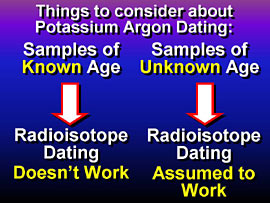 So again, when you test a sample of known age; it doesn't work. And if you test a sample of unknown age; it is assumed to work. We know it doesn't work when you know the age. But when you don't know the age they say it works. So it just doesn't work. I'm tired of them using our tax dollars to call that science. That is not science. That's pure imagination. There is a whole bunch more in the book The Evolution Cruncher if you want more on that. Or in the RATE project book, Radioisotopes and the Age of the Earth if you want more, or there's a whole lot of good stuff in Walt Brown's book, In the Beginning. He's a PhD in physics, an Air Force academy professor for years in Colorado. He got great stuff in here. I differ with him on a couple of little things. Of course I differ with probably everybody on a couple things. The only one right about everything is of course me. But we're trying to get them converted. We take a 5 minute break, come back and talk about: “Have fresh dinosaur bones been found?” So again, when you test a sample of known age; it doesn't work. And if you test a sample of unknown age; it is assumed to work. We know it doesn't work when you know the age. But when you don't know the age they say it works. So it just doesn't work. I'm tired of them using our tax dollars to call that science. That is not science. That's pure imagination. There is a whole bunch more in the book The Evolution Cruncher if you want more on that. Or in the RATE project book, Radioisotopes and the Age of the Earth if you want more, or there's a whole lot of good stuff in Walt Brown's book, In the Beginning. He's a PhD in physics, an Air Force academy professor for years in Colorado. He got great stuff in here. I differ with him on a couple of little things. Of course I differ with probably everybody on a couple things. The only one right about everything is of course me. But we're trying to get them converted. We take a 5 minute break, come back and talk about: “Have fresh dinosaur bones been found?”
| |
|
 |
|
Creation Science Evangelism
488 Pearl Lane
Repton, AL 36475
1 (855) BIG-DINO (244-3466)
Official Website |

Copyright © 2005. Made available on the Internet by Michel Snoeck, A.D. 2013.
This page revised:
6 August, 2019
|
|



 If light shines through a prism, it breaks it up into the rainbow colors; red, orange, yellow, green, blue, indigo and violet. Now if you take starlight and shine it into a prism, by putting a prism onto the back of your telescope, the light shines through and it gets broken up into the same colors; red, orange, yellow, green, blue, indigo, and violet. And you can kind of tell what's burning, because different things burn different colors, like copper burns green.
If light shines through a prism, it breaks it up into the rainbow colors; red, orange, yellow, green, blue, indigo and violet. Now if you take starlight and shine it into a prism, by putting a prism onto the back of your telescope, the light shines through and it gets broken up into the same colors; red, orange, yellow, green, blue, indigo, and violet. And you can kind of tell what's burning, because different things burn different colors, like copper burns green.  And each element produces a distinctive color and so they can kind of tell what's in the star and what it's burning by what color of light it produces. You can learn a lot about the stars from the light. However, as they look at this spectroscope, the colors it produces, there is little black lines in starlight indicating a particular element is burning, a particular element is burning, but they are shifted toward the red. You notice the center picture up there, the black lines are shifted toward the red side; and that's called the redshift.
And each element produces a distinctive color and so they can kind of tell what's in the star and what it's burning by what color of light it produces. You can learn a lot about the stars from the light. However, as they look at this spectroscope, the colors it produces, there is little black lines in starlight indicating a particular element is burning, a particular element is burning, but they are shifted toward the red. You notice the center picture up there, the black lines are shifted toward the red side; and that's called the redshift. 

 This fellow said in Sky and Telescope magazine: “Thus for us the only conclusion is that at least some quasars are relatively nearby, and that a large fraction of their redshift is due to something other than the expansion of the universe.”
This fellow said in Sky and Telescope magazine: “Thus for us the only conclusion is that at least some quasars are relatively nearby, and that a large fraction of their redshift is due to something other than the expansion of the universe.” This article says: “A quasar with an enormous redshift was found embedded in a nearby spiral galaxy with a far lower redshift.” Now how can one star be inside another star, and they're giving you two different redshifts, if this indicates distance? If a quasar is inside a galaxy, they should both give you the same redshift; both being the same distance away. But they admitted they found this quasar inside a galaxy that had different redshifts, but yet they were obviously the same distance away. So they said: “According to the standard Big Bang view of the universe, the objects we call quasars are generally supposed to be at the very edge of the visible universe. They are supposed to be super-luminous black holes with a million or 100 million times more mass than our sun, surrounded by a disk of material. Some of the material falls into the black hole, causing the emission of huge amounts of energy.”
This article says: “A quasar with an enormous redshift was found embedded in a nearby spiral galaxy with a far lower redshift.” Now how can one star be inside another star, and they're giving you two different redshifts, if this indicates distance? If a quasar is inside a galaxy, they should both give you the same redshift; both being the same distance away. But they admitted they found this quasar inside a galaxy that had different redshifts, but yet they were obviously the same distance away. So they said: “According to the standard Big Bang view of the universe, the objects we call quasars are generally supposed to be at the very edge of the visible universe. They are supposed to be super-luminous black holes with a million or 100 million times more mass than our sun, surrounded by a disk of material. Some of the material falls into the black hole, causing the emission of huge amounts of energy.” The article goes on to say: “You have to be very careful about drawing conclusions because all of the Hubble constant measurements have huge systematic errors.” I like this article which came out in Discover magazine a couple years ago: “Astronomers believed the Veil, one of the best studied supernova remnants, was 2,500 Light Years away and 18,000 years old. They were quite wrong. In fact, the Veil is only 1,500 Light Years away and 5,000 years old.”
The article goes on to say: “You have to be very careful about drawing conclusions because all of the Hubble constant measurements have huge systematic errors.” I like this article which came out in Discover magazine a couple years ago: “Astronomers believed the Veil, one of the best studied supernova remnants, was 2,500 Light Years away and 18,000 years old. They were quite wrong. In fact, the Veil is only 1,500 Light Years away and 5,000 years old.” The Bible says in the book of Isaiah 42: “God stretched out the heavens.” Isaiah 45: He “stretched out the heavens.” Jeremiah 10 (v. 12): He “stretched out the heavens.” 17 times in the Bible, it says: “God stretched out the heavens.” Now what does that mean? Well, I would guess it means that He stretched out the heavens, ok. I don't know that anybody knows, but here's a couple of options about what may be causing this redshift. Keep in mind, the redshift is probably the only bit of scientific data that is used to support the Big Bang theory. They look at the stars and say: “Wow, redshift, redshift, redshift, redshift. All these stars are moving away. What does that mean? Oh, that means they used to be all in one spot.” So the evidence for the Big Bang is the redshift. And the Big Bang has got to be one of the dumbest theories in the history of humanity. Here are some things that might be causing the redshift.
The Bible says in the book of Isaiah 42: “God stretched out the heavens.” Isaiah 45: He “stretched out the heavens.” Jeremiah 10 (v. 12): He “stretched out the heavens.” 17 times in the Bible, it says: “God stretched out the heavens.” Now what does that mean? Well, I would guess it means that He stretched out the heavens, ok. I don't know that anybody knows, but here's a couple of options about what may be causing this redshift. Keep in mind, the redshift is probably the only bit of scientific data that is used to support the Big Bang theory. They look at the stars and say: “Wow, redshift, redshift, redshift, redshift. All these stars are moving away. What does that mean? Oh, that means they used to be all in one spot.” So the evidence for the Big Bang is the redshift. And the Big Bang has got to be one of the dumbest theories in the history of humanity. Here are some things that might be causing the redshift.  Robert Gentry's got a great article in his website, www.halos.com. If you want to read more about the redshift and the problems with it, get all the technical stuff. But when you talk about the stars,
Robert Gentry's got a great article in his website, www.halos.com. If you want to read more about the redshift and the problems with it, get all the technical stuff. But when you talk about the stars,  there's a good book here by Brian Young called, The Stars: God's Word in the Sky. You can get it from our ministry for $10.00. It's a great book on the stars. Christians shouldn't be afraid of astronomy. Now, astrology is different. But not, astronomy, God created everything. Here's a book, Astronomy and the Bible. I don't know if this one's available from our website or not, but we can get Donald B. DeYoung. It is, Jonathan? Yes, it is on our website. An awesome book. If you want to read more, because I think we should study astronomy, study what God has made.
there's a good book here by Brian Young called, The Stars: God's Word in the Sky. You can get it from our ministry for $10.00. It's a great book on the stars. Christians shouldn't be afraid of astronomy. Now, astrology is different. But not, astronomy, God created everything. Here's a book, Astronomy and the Bible. I don't know if this one's available from our website or not, but we can get Donald B. DeYoung. It is, Jonathan? Yes, it is on our website. An awesome book. If you want to read more, because I think we should study astronomy, study what God has made.  This book is a little controversial. D. James Kennedy, of Coral Ridge Ministries, Coral Ridge Presbyterian Church in Fort Lauderdale, Florida. He says, the zodiac, he goes through the 12 zodiac symbols and says probably these originally had a gospel story to them, which has now been perverted into the horoscope. So go to www.coralridge.org if you want to get the book, which is about $6.00 or $8.00. But the Bible does talk about the constellations. It talks about Pleiades and Orion in Job 38 (v. 31). And Mazzaroth and Arcturus in Job 38 (v. 32-33). There are constellations mentioned in the Bible. Now what does this mean? Now I don't know, and I don't know anybody who knows for sure, but here's what some Christians think. That when God originally made the world, Adam did not have a Bible, it hadn't been written yet. So God gave Adam the Gospel story in the stars.
This book is a little controversial. D. James Kennedy, of Coral Ridge Ministries, Coral Ridge Presbyterian Church in Fort Lauderdale, Florida. He says, the zodiac, he goes through the 12 zodiac symbols and says probably these originally had a gospel story to them, which has now been perverted into the horoscope. So go to www.coralridge.org if you want to get the book, which is about $6.00 or $8.00. But the Bible does talk about the constellations. It talks about Pleiades and Orion in Job 38 (v. 31). And Mazzaroth and Arcturus in Job 38 (v. 32-33). There are constellations mentioned in the Bible. Now what does this mean? Now I don't know, and I don't know anybody who knows for sure, but here's what some Christians think. That when God originally made the world, Adam did not have a Bible, it hadn't been written yet. So God gave Adam the Gospel story in the stars.  The twelve different constellations told the story of the redemption, the coming of Christ. And may be the Sphinx, this is one theory, the Sphinx by the pyramid, you know, in Egypt. They say the Sphinx was built to tell us how to read the Zodiac, because it starts with the face of a woman, and ends with the body of a lion. So you start reading the zodiac, instead of starting in January, like we do, you should start with Virgo, the virgin, and you go through the twelve constellations and end with Leo the lion. I don't know. I know today the horoscope is all perverted, and Satan always takes what God does and twists it, perverts it, and changes it. But if you want to study that, that's fine. There appears to be something to that though, that may be there really is something to this Gospel in the stars. And Carl Baugh has a good theory, that each of the constellations is producing different radio waves. Stars produce radio waves. He thinks the canopy of ice that used to be above the earth could actually change those radio frequencies into audible waves, like a crystal radio does; it would actually vibrate. And Adam and Eve would be able to hear the music of the stars mentioned in Job chapter 38. Whether that's true or not, I don't know, but it sure preaches good that the whole Gospel story was being sung to them continually as they traveled around every year. Who knows?
The twelve different constellations told the story of the redemption, the coming of Christ. And may be the Sphinx, this is one theory, the Sphinx by the pyramid, you know, in Egypt. They say the Sphinx was built to tell us how to read the Zodiac, because it starts with the face of a woman, and ends with the body of a lion. So you start reading the zodiac, instead of starting in January, like we do, you should start with Virgo, the virgin, and you go through the twelve constellations and end with Leo the lion. I don't know. I know today the horoscope is all perverted, and Satan always takes what God does and twists it, perverts it, and changes it. But if you want to study that, that's fine. There appears to be something to that though, that may be there really is something to this Gospel in the stars. And Carl Baugh has a good theory, that each of the constellations is producing different radio waves. Stars produce radio waves. He thinks the canopy of ice that used to be above the earth could actually change those radio frequencies into audible waves, like a crystal radio does; it would actually vibrate. And Adam and Eve would be able to hear the music of the stars mentioned in Job chapter 38. Whether that's true or not, I don't know, but it sure preaches good that the whole Gospel story was being sung to them continually as they traveled around every year. Who knows?  Anyway, second question: “Is the Sun shrinking?” There has been some controversy among creationist groups in the last 10 years over this question. The sun is shrinking. There is not much question about that, but does that prove it's not billions of years old? Well, I think so. The sun is burning obviously. You can step outside and look at it. It's losing about 5 million tons every second; quite a weight loss program. Well, that means of course, that it used to be bigger. You don't need to be too much of a genius to figure that out. Bulletin of American Astronomical Society ran an article back in ’79, which some people have argued about, the legitimacy of this. But they said: “Since 1836, more than one hundred different observers at the Royal Greenwich Observatory [that's in England] and the U.S. Naval Observatory have made direct, visual measurements that suggest the sun's diameter is shrinking at a rate of about 0.1% each century or about 5 feet (1.5 m) an hour.”
Anyway, second question: “Is the Sun shrinking?” There has been some controversy among creationist groups in the last 10 years over this question. The sun is shrinking. There is not much question about that, but does that prove it's not billions of years old? Well, I think so. The sun is burning obviously. You can step outside and look at it. It's losing about 5 million tons every second; quite a weight loss program. Well, that means of course, that it used to be bigger. You don't need to be too much of a genius to figure that out. Bulletin of American Astronomical Society ran an article back in ’79, which some people have argued about, the legitimacy of this. But they said: “Since 1836, more than one hundred different observers at the Royal Greenwich Observatory [that's in England] and the U.S. Naval Observatory have made direct, visual measurements that suggest the sun's diameter is shrinking at a rate of about 0.1% each century or about 5 feet (1.5 m) an hour.” But I think we could all agree, the sun is burning. I think we could all agree it's getting smaller. “Several indirect techniques also confirm that the sun is shrinking, although these inferred about 1/7th as much.”
But I think we could all agree, the sun is burning. I think we could all agree it's getting smaller. “Several indirect techniques also confirm that the sun is shrinking, although these inferred about 1/7th as much.” Well, if you go back billions of years, you would assume this would make a problem. If the sun were bigger, it would pretty soon absorb Mercury and then Venus and then Earth. I don't know how far back you'd have to go and I think Christians would be wise to not put a number on it. Don't say, well, you know, 18.6 million years ago, this would happen. Because what happens, the atheist then atheists argue about the number, and they miss the whole point. They miss the concept. The fact is, guys, it is burning. It used to be bigger. This creates a problem for your theory. A bigger problem, though, than just the size of the sun, is the mass.
Well, if you go back billions of years, you would assume this would make a problem. If the sun were bigger, it would pretty soon absorb Mercury and then Venus and then Earth. I don't know how far back you'd have to go and I think Christians would be wise to not put a number on it. Don't say, well, you know, 18.6 million years ago, this would happen. Because what happens, the atheist then atheists argue about the number, and they miss the whole point. They miss the concept. The fact is, guys, it is burning. It used to be bigger. This creates a problem for your theory. A bigger problem, though, than just the size of the sun, is the mass.  Gravity is directly proportional to how heavy the objects are, the mass of the object. If the sun were more massive, gravity would be stronger. And that is going to start sucking planets in, drawing them out of their orbits. So yes the sun is shrinking, and I think it creates a problem for those who want to believe that the universe is billions of years old. I wouldn't put a number on it, but it certainly makes a problem somewhere.
Gravity is directly proportional to how heavy the objects are, the mass of the object. If the sun were more massive, gravity would be stronger. And that is going to start sucking planets in, drawing them out of their orbits. So yes the sun is shrinking, and I think it creates a problem for those who want to believe that the universe is billions of years old. I wouldn't put a number on it, but it certainly makes a problem somewhere.  Ok, “What about carbon dating?” I get asked this question all the time. Jonathan spent $70.00 to get this book, alright, and the new one is out, and it's $80.00 now? $80.00. Radioisotopes and the Age of the Earth. The RATE Project, R-A-T-E. I am sure not the world's expert on carbon dating. But I think I can explain things. I am a teacher. I can explain it as best I can. That's what a teacher is supposed to do. Take the complex and explain it so that the average person can get it. Since I operate at about fourth grade level, you know, I have to understand it myself first, so I can explain it. Let me explain how carbon dating is supposed to work. And then tell you the serious problems with it. Carbon dating was not invented until 1949, in the last 60 years. So when they started telling the kids the earth is billions of years old, back in 1830, they didn't tell them because of carbon dating. They'd never thought of carbon dating. It had never been heard of. Why were they teaching the earth is billions of years old 160 years ago? Well, because they needed billions of years to make their theory look good. That's why. I mean, if I told you a frog would turn into a prince if you kissed it, you don't say, well... it's a fairy tale. But if I told you: “Hey kids, the frog can turn to the prince if you wait billions of years.” Oh wow, may be so, now it becomes believable. No, it's still a fairy tale. It's a stupid idea.
Ok, “What about carbon dating?” I get asked this question all the time. Jonathan spent $70.00 to get this book, alright, and the new one is out, and it's $80.00 now? $80.00. Radioisotopes and the Age of the Earth. The RATE Project, R-A-T-E. I am sure not the world's expert on carbon dating. But I think I can explain things. I am a teacher. I can explain it as best I can. That's what a teacher is supposed to do. Take the complex and explain it so that the average person can get it. Since I operate at about fourth grade level, you know, I have to understand it myself first, so I can explain it. Let me explain how carbon dating is supposed to work. And then tell you the serious problems with it. Carbon dating was not invented until 1949, in the last 60 years. So when they started telling the kids the earth is billions of years old, back in 1830, they didn't tell them because of carbon dating. They'd never thought of carbon dating. It had never been heard of. Why were they teaching the earth is billions of years old 160 years ago? Well, because they needed billions of years to make their theory look good. That's why. I mean, if I told you a frog would turn into a prince if you kissed it, you don't say, well... it's a fairy tale. But if I told you: “Hey kids, the frog can turn to the prince if you wait billions of years.” Oh wow, may be so, now it becomes believable. No, it's still a fairy tale. It's a stupid idea.  But the geologic column is where it all started. We covered that on video #4, and some more on video #6 about the geologic column. The earth was divided up into layers; Cenozoic, Mesozoic, Paleozoic, Archaeozoic, etc. Each layer was assigned a name, an age, and an index fossil. We covered that on video four. Then they said: “Now we have to prove these layers are old.” So they picked the numbers out of the clear blue sky and any dating technique that comes along, like carbon dating or any other, has to match the geologic column, or it's rejected. Only because the geologic column has been taught for 180 years now, so surely it's true. No, just because it's been taught 180 years doesn't make it true. But that's the logic the scientists will have. “Oh, we know the geologic column is established, therefore any carbon dates we get should match that. If they don't, we'll throw them out. And we'll keep testing till we do.” They may have to test a sample 5 or 6 times till they get the number they want. Well, how do you know any of them are right then, if you are getting a different number every time? How would you know that any of them are right? “Radiometric dating would not have been feasible, if the geologic column had not been erected first.”
But the geologic column is where it all started. We covered that on video #4, and some more on video #6 about the geologic column. The earth was divided up into layers; Cenozoic, Mesozoic, Paleozoic, Archaeozoic, etc. Each layer was assigned a name, an age, and an index fossil. We covered that on video four. Then they said: “Now we have to prove these layers are old.” So they picked the numbers out of the clear blue sky and any dating technique that comes along, like carbon dating or any other, has to match the geologic column, or it's rejected. Only because the geologic column has been taught for 180 years now, so surely it's true. No, just because it's been taught 180 years doesn't make it true. But that's the logic the scientists will have. “Oh, we know the geologic column is established, therefore any carbon dates we get should match that. If they don't, we'll throw them out. And we'll keep testing till we do.” They may have to test a sample 5 or 6 times till they get the number they want. Well, how do you know any of them are right then, if you are getting a different number every time? How would you know that any of them are right? “Radiometric dating would not have been feasible, if the geologic column had not been erected first.” Plants breathe in carbon dioxide, and there's a very little bit of radio-active Carbon-14, 0.0000765%.
Plants breathe in carbon dioxide, and there's a very little bit of radio-active Carbon-14, 0.0000765%. 

 Carbon 14 is unstable. It does not like being carbon 14. It wants to get out of this situation, so it breaks down. About half of it will break down on a statistical average, about half of it is going to fall apart every 5,700 years. Now, it is doing this on a purely random procedure. I mean, you've got a pile of molecules. You never know which one is going to fall apart. But statistics tell us, about half of them will fall apart every 5,700 years, roughly. Now while it is carbon 14, it is floating around in the atmosphere. Like the rest of the carbon and it latches onto oxygen, like carbon often does and becomes carbon dioxide. And they hook up and they are happily floating around the atmosphere. And the plants are breathing in CO
Carbon 14 is unstable. It does not like being carbon 14. It wants to get out of this situation, so it breaks down. About half of it will break down on a statistical average, about half of it is going to fall apart every 5,700 years. Now, it is doing this on a purely random procedure. I mean, you've got a pile of molecules. You never know which one is going to fall apart. But statistics tell us, about half of them will fall apart every 5,700 years, roughly. Now while it is carbon 14, it is floating around in the atmosphere. Like the rest of the carbon and it latches onto oxygen, like carbon often does and becomes carbon dioxide. And they hook up and they are happily floating around the atmosphere. And the plants are breathing in CO Probably during your lifetime, you've either eaten plants or you've eaten animals that have eaten plants. How many of you have ever done that before? Like today for lunch right, ok. Everything we do is from one of those 2 sources, it is plants or animals that eat plants. Well, the plants are absorbing CO
Probably during your lifetime, you've either eaten plants or you've eaten animals that have eaten plants. How many of you have ever done that before? Like today for lunch right, ok. Everything we do is from one of those 2 sources, it is plants or animals that eat plants. Well, the plants are absorbing CO
 Anyway, this guy says even these diamonds have Carbon-14. He says they “cannot be contaminated. These constitute very strong evidence that the earth is only thousands, not billions of years old.”
Anyway, this guy says even these diamonds have Carbon-14. He says they “cannot be contaminated. These constitute very strong evidence that the earth is only thousands, not billions of years old.” But what you don't know is that I have drilled holes in the barrel. While you're putting it in, the water is leaking out. It's kind of like your checkbook, you know. You keep putting it in and it keeps leaking out someplace, right, how many of you have discovered that. You got a ring, Jonathan, you are discovering it now, right. Well, the earth's atmosphere is kind of like this barrel. It's always getting brand new Carbon-14. 21 pounds every year being put in, and it's always leaking out through decay. So the question would be, how long would it take to reach a stage called equilibrium? Now with a barrel, you can actually do the math and calculate, if I'm gonna put in a certain amount of water per minute and a certain amount per minute leaks out, when will I reach equilibrium, and where... this can all be calculated, you know, with a little bit of math. And with the atmosphere, they said: “When will the atmosphere reach equilibrium?” So, the guys who invented carbon dating in the late ’40s said: “I wonder about this Earth's atmosphere reaching equilibrium.” They did a bunch of studies on that, and said: “Now, if we took a brand new planet earth, created it from scratch, and got it going around the sun, how long would it take to reach this equilibrium point in the atmosphere where the production rate and the destruction rate is the same?” And they determined it would take about 30,000 years to reach equilibrium. I'm not sure how they did all that, you can probably see some RATE scientist and figure it out. Then they made two mistakes, in my totally unbiased opinion. They said:
But what you don't know is that I have drilled holes in the barrel. While you're putting it in, the water is leaking out. It's kind of like your checkbook, you know. You keep putting it in and it keeps leaking out someplace, right, how many of you have discovered that. You got a ring, Jonathan, you are discovering it now, right. Well, the earth's atmosphere is kind of like this barrel. It's always getting brand new Carbon-14. 21 pounds every year being put in, and it's always leaking out through decay. So the question would be, how long would it take to reach a stage called equilibrium? Now with a barrel, you can actually do the math and calculate, if I'm gonna put in a certain amount of water per minute and a certain amount per minute leaks out, when will I reach equilibrium, and where... this can all be calculated, you know, with a little bit of math. And with the atmosphere, they said: “When will the atmosphere reach equilibrium?” So, the guys who invented carbon dating in the late ’40s said: “I wonder about this Earth's atmosphere reaching equilibrium.” They did a bunch of studies on that, and said: “Now, if we took a brand new planet earth, created it from scratch, and got it going around the sun, how long would it take to reach this equilibrium point in the atmosphere where the production rate and the destruction rate is the same?” And they determined it would take about 30,000 years to reach equilibrium. I'm not sure how they did all that, you can probably see some RATE scientist and figure it out. Then they made two mistakes, in my totally unbiased opinion. They said:  It doesn't work. There's a website, www.arky.org, he's got more stuff on the earth has not reached equilibrium, you got some articles there by Ron Cooper. But this is a calibration curve. If an animal is still alive, it should give you about 16 clicks on your Geiger counter per minute per gram. If you're only getting eight, you say it's been through one half-life or four clicks, two half-lives, three half-lives, etc. This is called the calibration curve. In theory it sounds like it should work. But there are several real obvious assumptions. I don't know how they don't see it.
It doesn't work. There's a website, www.arky.org, he's got more stuff on the earth has not reached equilibrium, you got some articles there by Ron Cooper. But this is a calibration curve. If an animal is still alive, it should give you about 16 clicks on your Geiger counter per minute per gram. If you're only getting eight, you say it's been through one half-life or four clicks, two half-lives, three half-lives, etc. This is called the calibration curve. In theory it sounds like it should work. But there are several real obvious assumptions. I don't know how they don't see it.  Seven inches (18 cm) tall.
Seven inches (18 cm) tall.  When they first invented carbon dating in 1949, William Libby did some testing and they said: “The lower leg of a mammoth was 15,000 years old, but the skin was 21,000.” How can two parts of the same animal be different ages? Quite obviously, we know one of the numbers is wrong. So how would you know either of them are right? And if either one is right, how would you know which one? I see no way to tell. Well, let's see if it is getting better.
When they first invented carbon dating in 1949, William Libby did some testing and they said: “The lower leg of a mammoth was 15,000 years old, but the skin was 21,000.” How can two parts of the same animal be different ages? Quite obviously, we know one of the numbers is wrong. So how would you know either of them are right? And if either one is right, how would you know which one? I see no way to tell. Well, let's see if it is getting better.  In 1971, a freshly killed seal was 1,300 years old when they carbon dated it.
In 1971, a freshly killed seal was 1,300 years old when they carbon dated it.  This whole blessed thing is nothing but 13th Century alchemy.” And I agree. That's 1981. I've got all these in chronological order. It never gets better.
This whole blessed thing is nothing but 13th Century alchemy.” And I agree. That's 1981. I've got all these in chronological order. It never gets better.  February of 2005. He had dated the ‘Bischof-Speyer’ skeleton at 21,300 years old, but when they tested it at Oxford, they said it was only 3,300 years old.
February of 2005. He had dated the ‘Bischof-Speyer’ skeleton at 21,300 years old, but when they tested it at Oxford, they said it was only 3,300 years old. [1975] In the Geological Survey Professional Paper 862, and I get some flack over this, but I've got the paper in the library somewhere. We couldn't find it here. There are all kinds of articles about carbon dating of things in Alaska. I just want to show you a few things here. They carbon dated sample #SI454. See that on the chart there and said it was 17,210 years plus or minus 500. Then they tested sample #SI455 and said: “It's 24,140 years old.” Well, 17,000, or 24,000, you say that's looking good until you find out that's the same sample as 454. Very same sample, tested again. So is it 17,000 or 24,000? Sample #299 was less than 20,000 years old. That little carat means less than. Sample #L136 is greater than 28,000. You say: “Well, that's working good.” This sample is less than 20,000 and that other sample is more than 28,000, until you find out it's the same sample as #299. How can a sample be less than 20 and greater than 28 at the same time? I taught algebra for a long time, and I don't think you can do such a thing. That's not too good.
[1975] In the Geological Survey Professional Paper 862, and I get some flack over this, but I've got the paper in the library somewhere. We couldn't find it here. There are all kinds of articles about carbon dating of things in Alaska. I just want to show you a few things here. They carbon dated sample #SI454. See that on the chart there and said it was 17,210 years plus or minus 500. Then they tested sample #SI455 and said: “It's 24,140 years old.” Well, 17,000, or 24,000, you say that's looking good until you find out that's the same sample as 454. Very same sample, tested again. So is it 17,000 or 24,000? Sample #299 was less than 20,000 years old. That little carat means less than. Sample #L136 is greater than 28,000. You say: “Well, that's working good.” This sample is less than 20,000 and that other sample is more than 28,000, until you find out it's the same sample as #299. How can a sample be less than 20 and greater than 28 at the same time? I taught algebra for a long time, and I don't think you can do such a thing. That's not too good.  I was in a debate one time, and this professor was getting so upset. Finally, he said: “How can you use ‘Reader's Digest’ as a resource?” I said: “Sir, I use the ‘Reader's Digest’ as a resource for the picture of the dinosaur bone. It's not the resource for the fact, ok. That's where I got the picture from.” - “Oh, ok, ok,” and we went on with the debate. But yes, dinosaurs are today 70 million years old. A Russian scientist dated dinosaur bones at less than 30,000 years old. Hugh Miller from Columbus, Ohio took in four dinosaur bone samples and said: “Will you carbon date these?” And they charge like $600.00 to carbon date something. They carbon dated them and said they are less than 20,000 years old. He said: “Oh, by the way, these are dinosaur bones.” They said: “Oh, then they're not 20,000. We've got to test them again.” Why can't they be 20,000? They said: “Well, we know dinosaurs lived 70 million years ago, so if you had told us that, we never would have carbon dated them.” One friend of mine, died here several years ago, but he was digging and doing a lot of archaeological work. And he dug down in this well and he found layers of burned wood, which is good to carbon date, because obviously, you know, it had carbon in it. And he put it in bag, labeled it Sample A from such and such a layer and however many feet down, he labeled it A. He dug down ten or 20 more feet (3 to 6 m), found another layer of burned wood. (A city had been destroyed.) He labeled that one Sample B. He took them in to have them carbon dated. He paid them $600.00. They said Sample A is, I forget, 3,000 years old and this one is 4,000 years old. He waited 6 months, switched the labels, took them back into the same laboratory, and said, I want you to carbon date these samples. Now, sample B, the lower one, is in the top bag, just switched the label sand he's been given the same results, 3,000 and 4,000. It doesn't work. It has never worked.
I was in a debate one time, and this professor was getting so upset. Finally, he said: “How can you use ‘Reader's Digest’ as a resource?” I said: “Sir, I use the ‘Reader's Digest’ as a resource for the picture of the dinosaur bone. It's not the resource for the fact, ok. That's where I got the picture from.” - “Oh, ok, ok,” and we went on with the debate. But yes, dinosaurs are today 70 million years old. A Russian scientist dated dinosaur bones at less than 30,000 years old. Hugh Miller from Columbus, Ohio took in four dinosaur bone samples and said: “Will you carbon date these?” And they charge like $600.00 to carbon date something. They carbon dated them and said they are less than 20,000 years old. He said: “Oh, by the way, these are dinosaur bones.” They said: “Oh, then they're not 20,000. We've got to test them again.” Why can't they be 20,000? They said: “Well, we know dinosaurs lived 70 million years ago, so if you had told us that, we never would have carbon dated them.” One friend of mine, died here several years ago, but he was digging and doing a lot of archaeological work. And he dug down in this well and he found layers of burned wood, which is good to carbon date, because obviously, you know, it had carbon in it. And he put it in bag, labeled it Sample A from such and such a layer and however many feet down, he labeled it A. He dug down ten or 20 more feet (3 to 6 m), found another layer of burned wood. (A city had been destroyed.) He labeled that one Sample B. He took them in to have them carbon dated. He paid them $600.00. They said Sample A is, I forget, 3,000 years old and this one is 4,000 years old. He waited 6 months, switched the labels, took them back into the same laboratory, and said, I want you to carbon date these samples. Now, sample B, the lower one, is in the top bag, just switched the label sand he's been given the same results, 3,000 and 4,000. It doesn't work. It has never worked.  Here are some things to consider about carbon dating. When you date a sample of known age; it doesn't work. If you date a sample of unknown age; it is assumed to work. That's not science, ok. As things decay, they produce helium. This helium, the amount of helium in the atmosphere is only enough to account for a few thousand or a few million years, not billions of years.
Here are some things to consider about carbon dating. When you date a sample of known age; it doesn't work. If you date a sample of unknown age; it is assumed to work. That's not science, ok. As things decay, they produce helium. This helium, the amount of helium in the atmosphere is only enough to account for a few thousand or a few million years, not billions of years. They do a lot of testing on this. They are probably the experts on this in the creation community. This guy said: “The rocks do date the fossils, but the fossils date the rocks more accurately.”
They do a lot of testing on this. They are probably the experts on this in the creation community. This guy said: “The rocks do date the fossils, but the fossils date the rocks more accurately.” I talked to him back in 1999. He's in Oklahoma, and there is his phone number. He was the Chief of Engineering and Operations for the Lunar and Earth Science Division of the Manned Spacecraft Center for NASA in Houston. He worked on Lunar samples including the Genesis rock. He told me they found ages from 10,000 years to several billion in the same rock. His website is, www.jpdawson.com. How can one rock be 10,000 years old and several billion years old at the same time? Something is wrong, ok. The book, Bones of Contention has a great chapter at the end called, “The Dating Game” showing how that they will just change the dates whenever necessary. If it doesn't fit the theory, oh, let's test it again, until it fits the theory. See, the theory is important. The facts are not. Evolution as I have said many times, is a carefully protected state religion. And that's all it is.
I talked to him back in 1999. He's in Oklahoma, and there is his phone number. He was the Chief of Engineering and Operations for the Lunar and Earth Science Division of the Manned Spacecraft Center for NASA in Houston. He worked on Lunar samples including the Genesis rock. He told me they found ages from 10,000 years to several billion in the same rock. His website is, www.jpdawson.com. How can one rock be 10,000 years old and several billion years old at the same time? Something is wrong, ok. The book, Bones of Contention has a great chapter at the end called, “The Dating Game” showing how that they will just change the dates whenever necessary. If it doesn't fit the theory, oh, let's test it again, until it fits the theory. See, the theory is important. The facts are not. Evolution as I have said many times, is a carefully protected state religion. And that's all it is.  “What about potassium-argon (K-Ar) dating? Does that work?” Actually, the numbers are bigger, but the problems and assumptions are exactly the same. And you can demonstrate it doesn't work. Potassium decays very slowly. This chart shows the different elements and their half-lives. Carbon has a half-life of around 5,700 years, but potassium it takes 1.3 billion years, with a ‘b’, for half of that to disappear. It very slowly decays. By the way, I would like to point out, Your Honor, just for, you know, appeal, that all the dating methods are based on the decay of an element. Uranium decays to lead. Potassium decays to argon. They are all moving down the Periodic Table; not up. All going down. Just point out, keep that in mind in case we need to appeal this case, alright. “80% of the potassium in a small sample of an iron meteorite can be removed by distilled water in 4½ hours.”
“What about potassium-argon (K-Ar) dating? Does that work?” Actually, the numbers are bigger, but the problems and assumptions are exactly the same. And you can demonstrate it doesn't work. Potassium decays very slowly. This chart shows the different elements and their half-lives. Carbon has a half-life of around 5,700 years, but potassium it takes 1.3 billion years, with a ‘b’, for half of that to disappear. It very slowly decays. By the way, I would like to point out, Your Honor, just for, you know, appeal, that all the dating methods are based on the decay of an element. Uranium decays to lead. Potassium decays to argon. They are all moving down the Periodic Table; not up. All going down. Just point out, keep that in mind in case we need to appeal this case, alright. “80% of the potassium in a small sample of an iron meteorite can be removed by distilled water in 4½ hours.” When the rock gets melted and shot out of a volcano, all the gas escapes. And so the theory says, this new layer should have been..., the clock is now reset. It is zero years old. Even though when it was in the earth, it's, you know, 4 billion years old, now all the argon is gone, because it accumulated this argon for millions of years, but now pooof, it melted and the gas is gone. So, we can potassium-argon date this lava or ash or any volcanic material. Well, they had been dating this layer of ash, named after Kay Behrensmeyer, because she did research on them [KBS = Kay Behrensmeyer Site]. They said it's 212 to 230 million years old. All the scientists agreed that layer of ash is around 200 million years old.
When the rock gets melted and shot out of a volcano, all the gas escapes. And so the theory says, this new layer should have been..., the clock is now reset. It is zero years old. Even though when it was in the earth, it's, you know, 4 billion years old, now all the argon is gone, because it accumulated this argon for millions of years, but now pooof, it melted and the gas is gone. So, we can potassium-argon date this lava or ash or any volcanic material. Well, they had been dating this layer of ash, named after Kay Behrensmeyer, because she did research on them [KBS = Kay Behrensmeyer Site]. They said it's 212 to 230 million years old. All the scientists agreed that layer of ash is around 200 million years old.  Until Richard Leakey came along in 1972. And he's digging around under the KBS Tuff, and he finds a perfectly normal human skull. Everybody panics and says: “How can you have a normal human skull under 200 million year old rock, when man didn't even evolve till like 3 million years ago? That's not possible.” And so they looked for things like, was this a burial site, did someone dig through and bury this person down here? Was there an earthquake? Is there a fault line near here someplace? No. All they could conclude is there was a normal human skull under 200 million year old rock. So what do you conclude? One group studied this and said: “Well, that proves aliens came here 200 million years ago.” Would you just consider that maybe the rock is not 200 million years old? After they found out that it could not be an intrusion, or a burial or anything else, it had to be legitimately placed there, I mean it was buried under this ash layer, they took 10 more samples of the KBS Tuff and dated them again. Keep in mind they had already dated them a bunch of times, and everybody agreed it was 212 million years old. But now they take ten more samples and checked them again and say: “Oh, no, it's only 0.5 to 2.6 million.”
Until Richard Leakey came along in 1972. And he's digging around under the KBS Tuff, and he finds a perfectly normal human skull. Everybody panics and says: “How can you have a normal human skull under 200 million year old rock, when man didn't even evolve till like 3 million years ago? That's not possible.” And so they looked for things like, was this a burial site, did someone dig through and bury this person down here? Was there an earthquake? Is there a fault line near here someplace? No. All they could conclude is there was a normal human skull under 200 million year old rock. So what do you conclude? One group studied this and said: “Well, that proves aliens came here 200 million years ago.” Would you just consider that maybe the rock is not 200 million years old? After they found out that it could not be an intrusion, or a burial or anything else, it had to be legitimately placed there, I mean it was buried under this ash layer, they took 10 more samples of the KBS Tuff and dated them again. Keep in mind they had already dated them a bunch of times, and everybody agreed it was 212 million years old. But now they take ten more samples and checked them again and say: “Oh, no, it's only 0.5 to 2.6 million.” By 1969, when I was a kid and they went to the moon, they brought back moon rocks and said: “Oh, they're 3.5 billion years old.” That was the official age; 3.5 billion. By the way, they did it with potassium-argon dating. You can see the article here from the newspaper.
By 1969, when I was a kid and they went to the moon, they brought back moon rocks and said: “Oh, they're 3.5 billion years old.” That was the official age; 3.5 billion. By the way, they did it with potassium-argon dating. You can see the article here from the newspaper.  So again, when you test a sample of known age; it doesn't work. And if you test a sample of unknown age; it is assumed to work. We know it doesn't work when you know the age. But when you don't know the age they say it works. So it just doesn't work. I'm tired of them using our tax dollars to call that science. That is not science. That's pure imagination. There is a whole bunch more in the book The Evolution Cruncher if you want more on that. Or in the RATE project book, Radioisotopes and the Age of the Earth if you want more, or there's a whole lot of good stuff in Walt Brown's book, In the Beginning. He's a PhD in physics, an Air Force academy professor for years in Colorado. He got great stuff in here. I differ with him on a couple of little things. Of course I differ with probably everybody on a couple things. The only one right about everything is of course me. But we're trying to get them converted. We take a 5 minute break, come back and talk about: “Have fresh dinosaur bones been found?”
So again, when you test a sample of known age; it doesn't work. And if you test a sample of unknown age; it is assumed to work. We know it doesn't work when you know the age. But when you don't know the age they say it works. So it just doesn't work. I'm tired of them using our tax dollars to call that science. That is not science. That's pure imagination. There is a whole bunch more in the book The Evolution Cruncher if you want more on that. Or in the RATE project book, Radioisotopes and the Age of the Earth if you want more, or there's a whole lot of good stuff in Walt Brown's book, In the Beginning. He's a PhD in physics, an Air Force academy professor for years in Colorado. He got great stuff in here. I differ with him on a couple of little things. Of course I differ with probably everybody on a couple things. The only one right about everything is of course me. But we're trying to get them converted. We take a 5 minute break, come back and talk about: “Have fresh dinosaur bones been found?”